DOCUMENTS OF VIETNAMESE ANCIENT CULTURE III
COLLECTED BY NGUYỄN THIÊN THỤ
20. Dong Son Drums
(C35 p.35)
The Dong Son period is characterized as a period lasting from 2000 BCE to 200CE, being the formation period of the Vietnamese nation under a royal dynasty. It also represents the end of the Bronze Age for the Iron Age. Aswell as the archeological material from the Dong Son period was very rich, its related culture is said to have had a great influence on its neigbor regions through important connections with the Tibeto-Burman, Thai and Mon-Khmer ultures. Such expansion can be explained thanks to the skillfulness of the Dong Son people, as they were great agricultur ists, fisherman or bold sailors. Living in large huts closed to the sea or rivers, their boatstraversed all the China Sea. Archeological discoveries in Thailand in the 1970's showed that bronze casting began in Southeast Asia before being borrowed by the Chinese. Such discoveries confirmed that the origin bronze drums of the Dong Son period can be closely related in basic structural features and decorative design to the pottery of the Phung Ngyuen culture (5000BCE~ 4000BCE), as well as being reported in South and Southwest China, Myanmar, Thailand, Laos and Indonesia. Up to 140 drums were also located throughout all Viet Nam. In fact, if most of the drums were made in Viet Nam or South China, they were trade in Java and Bali islands.
The purpose of these drums (religious ceremonies, wars...) is still uncertain. Nevertheless, they were appreciated for their very high artistic level compared to the others civilizations of that time. These drums depict the Dong Son Society in their daily chores or spiritual life with images of object, humans and animals. There is always a star on their center, encircled by concentric panels of scenes with humans and animals or geometric motifs. It can be understand from these pictures the rituals of the Dong Son people and their constant fighting for survival against peoples from the North.Dr. Franz Hager, an Austrian ethnographer, gave his name in 1902 to a classification of Southeast Asian drums (Alte Metalltrommeln aus Südost-Asien). The classification categorized the bronze drums by their shape, dimension, weight, decorative design, chemical composition, and casting techniques in four types (I to IV, see below).
Thanks
to new discoveries in 1975, Vietnamese archaeologists proposed a new
classification in five A close-up of the centre of the tympanum
dominated by an eight-point star with butterfly motifs between the
rays.Birds, deer, buffaloes and hornbills were depicted. categories
(A to E, see below). In these classifications, due to their
characteristics, the Dong Son drums should be classified in groups I and
B. Franz Hager’s classification Vietnamese archeologists’
classification Date Grp Examples Size & Shape Design Discovery 6BCE
to 3BCE A Ngoc Lu, Hoang Ha, Co Loa, Song Da, Mieu Mon Face: 60-70cm
dia. Height: 40-50cm; large & proportional; shouder and body of
equal dimensions vivid, rich & composed mostly in Viet Nam; drums
with sloping body were usually found in the highland while those having
vertical straight body were mostly found in the plain 5BCE to 1BCE B Duy
Tien, Yen Tap, Phu Duy, Dong Son Face: 56-5cm dia. Height: 47-53cm;
slender & tall body simpler and marked different geometric motifs
from Group Amostly in Viet Nam 4BCE to 1CE C Hieu Chung, Dong Hieu,
Thanh Van Face: 34-116cm dia. Height: 24-92cm sophisticated &
stylized as Group A; 4 frog sculptures near the rim of the ace mostly in
Viet Nam 4BCE to 1CE D Dao Xa, Tung Lam Face: 26-52cm dia. Height:
24-38cm heavy body; broad shoulder, steep slope &
shorter base ew, simple & crude; Flaws resulted from poor casting techniques few in Viet Nam & mostly in Southern China 1CE to 4CE E Cao Bang Face: 35-88cm dia. Height: 21-62cm undefined & dispropotional shoulder, body & base simple & meager; influenced from other cultural orms; some only 1/3 of face mostly in Southern China Casting bronze drums of Dong Sun is saidto be a very complex process equiring advanced techniques and huge artistic skills. The lost-wax casting technique was used, and smelting 1 to 7 tons of copper was necess ary for building one "Co Loa" drum. Separate circular and rectangular clay moulds for ifferent part of the drum were prepared and impress with a patterned old or incised with a stylus. At the end, the rocedure gives the impression of a wax drum over a clay core. How ever difficult their production was, drums of the ong Son period were a key element of the culture of the becoming Viet Nam, just before the Common Era. Even if he purpose of these drums is still unclear, requiring a high level of technique and a great sense of art, it allowed the Dong Son people to have a great influence on cultures in Southeast Asia at this period. Thanks to their precise depictions, archeologists were also able to understand their daily lives and rituals. References: [1] viettouch.com: Viet Nam History/Pre-Historic
http://www.viettouch.com/pre-hist/
[2]
L'Asie EXotique: Frog Drums and their importance inKaren Culture, Sylvia Fraser-Lu‐http://www.lasieexotique.com/mag_frogdrums.html Ken GÉGOUT 04M54040‐ken@tt.cs.titech.ac.jp Investment of the wax in a layer of very fine clay followed before the assemblage was covered in a coarse clay coat. It was then necessary to melt out the wax, https://www.blogger.com/blogger.g?blogID=6565178343930682357#editor/target=post;postID=6381501113624564175;onPublishedMenu=allposts;onClosedMenu=allposts;postNum=3;src=link
shorter base ew, simple & crude; Flaws resulted from poor casting techniques few in Viet Nam & mostly in Southern China 1CE to 4CE E Cao Bang Face: 35-88cm dia. Height: 21-62cm undefined & dispropotional shoulder, body & base simple & meager; influenced from other cultural orms; some only 1/3 of face mostly in Southern China Casting bronze drums of Dong Sun is saidto be a very complex process equiring advanced techniques and huge artistic skills. The lost-wax casting technique was used, and smelting 1 to 7 tons of copper was necess ary for building one "Co Loa" drum. Separate circular and rectangular clay moulds for ifferent part of the drum were prepared and impress with a patterned old or incised with a stylus. At the end, the rocedure gives the impression of a wax drum over a clay core. How ever difficult their production was, drums of the ong Son period were a key element of the culture of the becoming Viet Nam, just before the Common Era. Even if he purpose of these drums is still unclear, requiring a high level of technique and a great sense of art, it allowed the Dong Son people to have a great influence on cultures in Southeast Asia at this period. Thanks to their precise depictions, archeologists were also able to understand their daily lives and rituals. References: [1] viettouch.com: Viet Nam History/Pre-Historic
http://www.viettouch.com/pre-hist/
[2]
L'Asie EXotique: Frog Drums and their importance inKaren Culture, Sylvia Fraser-Lu‐http://www.lasieexotique.com/mag_frogdrums.html Ken GÉGOUT 04M54040‐ken@tt.cs.titech.ac.jp Investment of the wax in a layer of very fine clay followed before the assemblage was covered in a coarse clay coat. It was then necessary to melt out the wax, https://www.blogger.com/blogger.g?blogID=6565178343930682357#editor/target=post;postID=6381501113624564175;onPublishedMenu=allposts;onClosedMenu=allposts;postNum=3;src=link
21. Frog Drums
and There Importance
in Karen Culture
Arts of Asia September/October 1983 issue
by Sylvia Fraser-Lu
by Sylvia Fraser-Lu
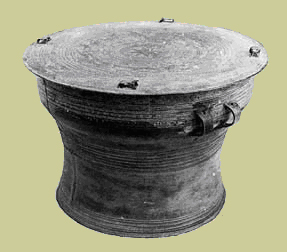
One-frog drum. Height 20.5 inches, diameter of tympanum 25 inches
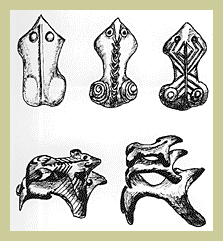
Drum base decorations
The Karen, numbering approximately two million on the
Burmese side, with a further 200,000 in Thailand, include sub-groups
such as the Skaw, the Pwo and Kayah. As with most hill tribes of
Southeast Asia, their origins are obscure. Karen legends point to the
upper reaches of the Huang Ho river in China as a possible centre of
origin, from which they migrated south-ward via Yunnan into Burma around
A.D. 600-700. They are traditional slash and burn agriculturalists and
formerly lived a longhouse way of life. As animists, they believed in
Nats, spirits that reside in rocks, trees, water and other
objects. At times these spirits might prove dangerous, and to ensure
that all went well, they had to be regularly propitiated with
sacrifices, offerings and taboos. Throughout their little known and
largely conjectural history, the Karens have always regarded the frog
drum as their most precious possession, believing that ownership
bestowed the triple boons of wealth, status and security on those
fortunate enough to own one.
Early British travellers to the present-day Shan states
and Kayah and Kawthoolei states noted that the Karen tribes had a
passion for the possession of frog drums or pazi,as they are called in
Burma. O'Riley, the first English district officer to Toungoo in 1857
remarked, "they [the drums] were held in such high esteem, that in the
more remote villages even children were bartered for them." The deep
sonorous tone of the drum was considered pleasing to the presiding N at
spirits of the mountains, and the resulting echoes signified their
approval and hence guaranteed good fortune to the people.
The drums were also used to summon the Karen ancestor
spirits, to remind them to be on hand to witness important ceremonies
such as marriage, house-warmings and funerals. At the same time the
sound of the drums implored them to look kindly on their kin below and,
when necessary in times of stress and misfortune, to use their good
offices in securing favours from the Nat spirits to ease the burdens of
those below.
The Karen also believed that a spirit resided within the
drum and at times it was thought beneficial to propitiate it with small
bowls of liquor and rice. Failure to do so might result in the early
death of the owner. Any changes to the surface of the drum were
carefully noted. For example, condensation on the surface was not
regarded as a good omen; it was interpreted as weeping and if nothing
was done, sickness and death could result. To avert such a calamity, a
ritual was performed with the blood of a chicken to appease the spirit
of the drum. The Rev. Harry Marshall, a leading authority on the Karen
people, has mentioned that some drums were regarded as auspicious and
others inauspicious. He also talks of "hot" drums that were beaten at
time of death and disaster, and "cool" ones used for festive occasions.
Unfortunately there is nothing physically different to make a definite
distinction between the two types of drums. Some of the more notable
ones were given special names which when translated could have meanings
such as "great resonance", "pure tone", etc.
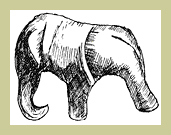 |
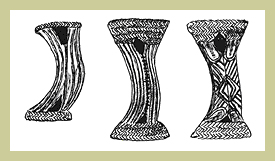 |
| The popular elephant motif | Three types of decorative handles |
The Karen used to store their
treasures in frog drums and bury them secretly in the ground, believing
that they could take their possessions with them after death. Until the
sixteenth century it was the custom of the Shan, Karen and other tribes
of eastern Burma at the death of a chief to bury his possessions,
including his wives, elephants, weapons and other valued objects. The
Karen, like other drum users in Yunnan and Vietnam, were known to bury
their drums with their owners. Bayinnaung (1551-1581), one of Burma's
greatest conquerors who in his heyday ruled over all of Burma (and a
large part of Thailand) except for the Arakan coast, being a devout
Buddhist forbade such funerary practices. As a compromise, token
offerings were subsequently placed in graves. In place of a complete
drum, a piece often in the form of a frog was cut off and buried. Hence
some of the older frog drums may be incomplete or repaired.

Drum base decoration
Dr Francis Mason in 1868 wrote that no Karen was considered
rich without a frog drum, regardless of whatever his precious
possessions might be. Anyone with money endeavoured to turn it into a
frog drum. Such drums were insurance against crop failure and famine,
for they could readily be sold to buy food in times of hardship. They
could be owned both by individuals or clans. A village with many drums
was the envy of other villages and was often the cause of inter-tribal
feuds to obtain possession of them. Drums were frequently beaten to
heighten morale before Karen warfare, which generally consisted of
making a lightning raid into a rival village, killing the inhabitants as
they tried to escape and then setting fire to the longhouse in which
the village lived. A successful outcome was naturally a cause for a
celebration and further beating of the drums.
The ownership of a drum also conferred status, for
according to tradition, the owner of such an item stood higher in the
community than if "he possessed seven elephants", the elephant being
highly prized in Southeast Asia. Drums often formed part of the gift
exchange preceding a marriage. They could be offered as compensation in
disputes settled at the behest of the village elders.
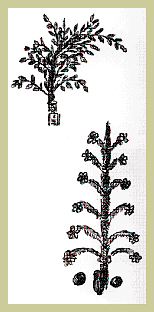
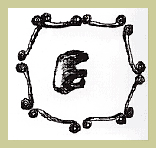 Drum base decorations
Drum base decorationsIn the past drums have also been used as tribute and valued gifts to the various overlords of Southeast Asia. There is an inscription circa A.D. 1056 attributed to King Manuha, the ruler of the Mon kingdom of Lower Burma shortly before its capture by Anoratha of Pagan, which states, "People went into his presence and repeatedly saluted him by popular vote to the sound of frog drums and applause." Anoratha's successor Kyanzittha (1084-1112) of the Pagan dynasty, according to an inscription included frog drums as part of a shipment of precious things that he sent to repair the holy shrine at Bodhgaya in India.
Lacquered and gold leafed frog drums set in horizontal
stands were important items of ritual in the Thai court, to be beaten
when the king appeared, and they were used intermittently by Thai
royalty even to this day. In a ceremony held on October 20th, 1982 when
Queen Sirikit formally presented the Phra Buddha Nava Rajaboptr image to
the city of Bangkok, frog drums formed part of the paraphernalia
carried in procession. The Thai kings were known to give them to
monasteries on occasions. King Rama IV, on his ascent to the throne,
donated several frog drums to Wat Ba Wan and Wat Phra Keow. His
successor Rama V, carrying on the tradition, gave two such drums to Wat
Bencha. The ex-king of Laos is reported as formerly having from thirty
to forty bronze drums in his possession.
 |
Man with feather costume which could be the fore-runner to the owl motif
|
 |
|
| Stylized flyign birds | |
| Some Non-geometric Motifs Seen on Type I Drums | |
Being primitive agriculturalists,
the Karen were very dependent on the kindness of the elements for their
welfare and livelihood. Consequently, it is not surprising to find that
their highly prized drums also played an important part in agricultural
rituals to secure abundant rainfall. So important was the agricultural
cycle of activities that the Karen names for the months of the year
reflect both the climate and the domestic and farming practices
associated with the seasons. Led by a pair of warrior leaders, the Karen
were also known to perform a line dance back and forth in two rows in a
ritual to bring on rain. Drums were beaten for other farming rituals
such as those at rice planting and harvest time. The valuable seed grain
for the next year's crops was sometimes kept safely stored in the
resonance case of a frog drum, which in addition to being impossible for
rats to climb up, was thought to impart some magic power to enhance the
efficacy of the germination process.
 |
| Three kinds of rosettes |
 |
| Small duck-like birds |
 |
| Two stylized owls |
 |
| Three larger birds |
 |
| Varieties of fish motifs |
 |
| Single lozenge patterns |
| Some Non-gemoetric Motifs Seen on Karen Drums |
The Karen also believed that the bronze drums linked them
to their remote past. Some associate the origin of the drums with Pu
Maw Taw, considered to be one of their early ancestors. He was a
diligent farmer who daily tended his steep hill rice fields located
close to a cave. His efforts to harvest his grain were constantly being
hampered by the depredations of a band of monkeys which continually
stole his grain. In despair the old man wearily lay down and pretended
to be dead. On finding him in a prone position, the monkeys clustered
around him, remorsefully saying, we have eaten his grain, now he is
dead. Let us perform a proper funeral for him." With that they carried
his body to the mouth of the cave. Several monkeys then went to get
their drums, which it appears they were in the habit of using for
funeral rites. Of the three drums brought, one was of gold, another
silver and the third white in appearance. As the monkeys were beating
the drums, the patriarch sat up and began gazing around. This unexpected
action caused the monkeys to flee in terror, leaving their drums
behind. Pu Maw Taw took them and they became the most sacred possessions
of the Karen people, who subsequently worshipped them in an annual
ceremony. Unfortunately squabbles amongst the various Karen groups
caused the drums to be stolen and lost to posterity.
Despite the overwhelming importance of the drums in
ritual and life, the Karen themselves, not being metalworkers, do not
seem to have made them. According to Karen lore, the earliest drums were
obtained from the Yu people, who could possibly have been the Jung or
Yung people who occupied Yunnan in ancient times. Early Chinese sources
have verified that bronze drums were used by the "Southern Barbarian"
tribes of southwestern China as far back as the second century B.C. It
is quite likely that they were in use in Yunnan when the ancestors of
the Karen passed through there from western China into Burma.
Throughout the nineteenth century it is known that Karen
bronze drums were cast by Shan craftsmen at Ngwedaung (Silver Muntain)
some eight miles south of Loikaw, the capital of Kayah state. These
craftsmen were also noted for making gongs, cow bells, silverware and
jewellery. In addition to the various sub-groups of Karen, buyers from
Laos, Thailand and Cambodia used to converge on Ngwedaung at the end of
the rainy season in October-November to purchase drums to sell to
various tribal groups such as the Tsa Khamu. They were bartered for
elephants, silver, gold and other merchandise. It is reported that at
one time U Sein of Loikaw even had a branch salesroom at The Burma House
on Merchant Street in Rangoon to promote the export of frog drums.
Because of the importance of the drums to the Karen,
master craftsmen had to undergo certain purification rites before a drum
could be cast at a time predetermined by astrological calculations. On
the day before, they were required to undergo a cleansing ritual to
invoke spiritual guidance during casting. After bathing, they made
offerings of fruit and candles, then slept undisturbed that evening.
When they arrived at the foundry the following morning, a circle was
marked out in which the casting was to be performed. Within this area
the wearing of footwear was prohibited. Swearing and the consumption of
intoxicants were also forbidden until the work was completed.
To begin the process and form the inside contour of the
drum, a hollow clay core is built up from finely wedged red clay mixed
with rice husks in the proportions of two parts of clay to one part rice
husks. When sufficiently hardened, it is smoothed by turning on a
lathe. It is then coated two to three times with a slip made from yellow
clay mixed with finely strained powdered cow dung. After further
shaping on a lathe, the form may be covered with a glue of boiled rice
water which helps serve as an adhesive for the wax.
A wax compound is made from a combination of
approximately ten parts of indwe tree resin, seven parts of beeswax and
four parts of crude oil. The thick brown wax is rolled out to a uniform
thickness, cut into squares and bonded to the clay core with crude oil.
The amount of wax used is carefully weighed so that the correct amount
of molten metal can later be added.
For decoration of the resonance case and tympanum,
concentric circles characteristic of frog drums are made with a blunt
chisel. Engraved motifs, such as birds and fish, are created with metal
dies. Repetitive geometric patterns may be impressed on the surface with
small rollers, while raised decoration, for instance the stylised tree
that sometimes appears at the base of a drum, is created with strips of
wax. Handles and three-dimensional figures, such as frogs and elephants,
are made from moulds or modelled separately, then pressed on to the surface.
Small sprues one to two inches long, which provide
conduits for the molten metal and escape routes for the wax and gases,
are set at various intervals over the surface of the drum. A slip of
white clay mixed with rice husks is carefully applied over the whole wax
surface, great care being taken to fill in all the tiniest crevices of
the designs. A thick three to four inch layer of clay kneaded with
either rice husks or horse dung is applied to form the outer mould. The
inner and outer moulds are aligned with small iron rods.
To harden the clay core and to remove the wax, the mould
is fired in a kiln constructed of mud and bricks. The molten metal,
usually consisting of a mixture of copper, lead, tin and zinc in varying
quantities, is poured into the mould from a ceramic crucible. Once the
metal has been poured in, the mould is completely covered with earth and
allowed to cool slowly for several days. When cold, the mould is broken
open to reveal the drum which is then cleaned and rubbed smooth. The
sprues and any other rough projections are filed even with the surface.
The colour of the drum depends on the alloys used in casting and ranges
from black and reddish brown"to greenish turquoise. The value of a drum
depends on the metal content, the tonal quality, the artistry of the
design and its ritual efficacy.
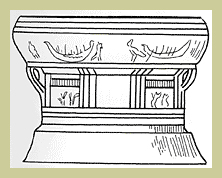 |
Type I
This oldest type of drum is characterised
by a mushroom shaped resonance case which is sharply divided into three
parts. The tympanum does not overlap. The central portion is fairly
straight with small semicircular handles joining to the bulbous portion.
The resonance case has large bands or panels with figures of men, birds
or animals. The decoration on the tympanum is similar. Motifs are
arranged in concentric bands surrounding a central star. Examples have
been found in Cambodia, Vietnam and adjacent regions.
|
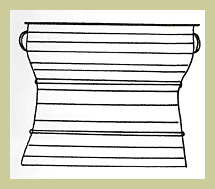 |
Type II
The drum outline is less pronounced than in
Type I. The handles are generally smaller and often circular. The
tympanum projects a little over the resonance case. The central star is
filiform and has fewer points than Type I drums. The decorative zones on
the tympanum and resonance case contain smaller figures than on Type I
drums. There are usually four frogs on the tympanum. These drums appear
to come from eastern China. |
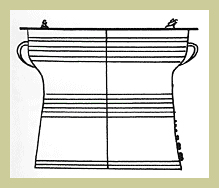 |
Type III
This type of drum is quite distinct from the
two above. The lines on the resonance case are more graceful and less
abrupt. The swelling of the upper portion is less pronounced. The
decorative designs on the tympanum, which overlaps the resonance case by
about an inch, are smaller, and consist of birds, fish, rosettes and
geometric decoration. At the base of the drum may be vegetal designs,
three-dimensional elephants and snail shells. This drum is the most
common type, and is found in Burma, Thailand and Laos. |
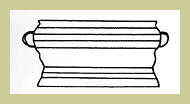 |
Type IV
This type of drum seems to be a later and
much squatter version of earlier drums. The star on the tympanum has
twelve rays, symbolic of the twelve months of the year. Geometric
designs are suggestive of the figures on Type I. There are no frogs.
Numerous examples have been found in Yunnan province of China. |
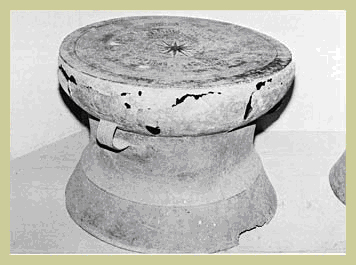 |
 Some Geometric Designs from
Karen Frog Drums
Some Geometric Designs from
Karen Frog Drums |
| Type I drum from the National Museum, Bangkok | |
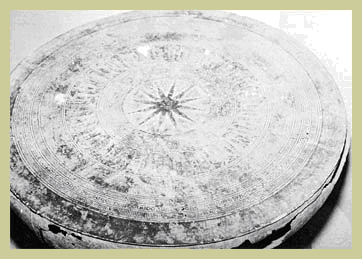 |
|
| Tympanum of drum above: Note the flying birds and feathered man motifs | |
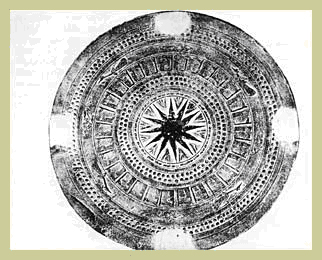 |
|
| A rubbing of a similar Type I drum found in China |
According to Dr Franz Heger's classification expounded in his pioneer study of bronze drums, Alte Metalltrommeln aus Südost-Asien (Leipzig,
1902), Karen drums have been classified as Type III drums. They exist
in far greater number than any other drum types in Asia and have
probably evolved from Type I examples.
There is a considerable variation in size of the drums.
The oldest Karen drums are generally smaller than the more recent
examples, but as many new ones are now being made in small to miniature
proportions, size is not a reliable indication of age. The overlapping
tympanum varies from about nine to thirty inches in diameter and the
resonance case is only slightly longer than the diameter of the
tympanum.
As with all bronze drums, a slightly raised star adorns
the centre of the tympanum. This star has an even number rays for
instance eight, ten, twelve, fourteen or sixteen, the points of which
may be relatively short or thread-like in shape. On the one-frog drums
the star usually has only eight rays, but there are exceptions to this.
Between the rays of the star may be seen an engraved heart-shaped motif
which resembles a resting butterfly with wings folded. On the earlier
drums this may be quite large, while on later examples it decreases in
size and may entirely disappear. Occasionally there are small rosettes
and circles between the outer rays of the star, the tips of which may
overlap into the first two to three narrow concentric rings surrounding
the star. These slightly raised rings spread out in ever widening
circles, dividing up the entire surface of the tympanum into bands for
decoration. The number of rings between each band varies with the number
of frogs superimposed on the tympanum. The smaller, earlier frog drums
average about fourteen decorative bands separated by single rings, while
the more recent three-frog drums usually have about nineteen bands
separated by a series of triple concentric rings.
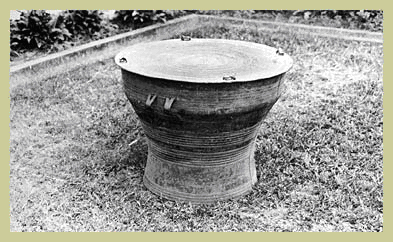 |
|
One-frog drum. Height 20 inches, diameter of tympanum 26 inches
|
|
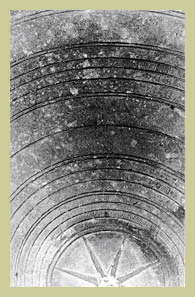 |
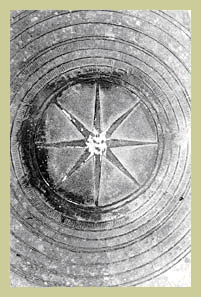 |
Judging
from the motifs (which are not clear) this is quite an old drum. The
large birds and fish are quite archaic. Note the double chain of grain
motif
|
The centre of this drum
has been repaired, as can be seen by the black tar ring. The star is a
later addition, for it lacks the butterfly motif typical of the older
drums
|
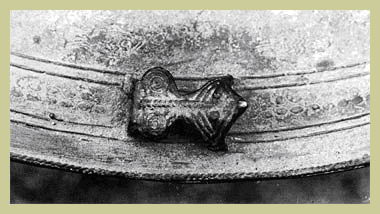 |
|
| The frog, although a little worn, is probably of later vintage than the rest of the drum | |
Decoration within these bands consists of both geometric
designs and stylized representations of plants and animals. The first
few bands closest to the star are incised with geometric motifs such as
short, even, parallel lines or radial rays and circles with a dot,
referred to by Heger as the "eye" motif On some later drums this becomes
a continuous chain of rosettes which may be repeated in double bands.
There arc various "rice grain" patterns. One of the earliest resembles a
row of melon seeds laid end to end and has come to be called the "chain
of grain" motif.
It may also be seen as a double layer of grain. On
some drums this design has small filaments at the side and is then
called "bearded rice". The continuous lozenge motif; consisting of a
diamond shape surrounded by parallel lines, is another popular design
seen on frog drums. A variation of Chinese thunder pattern is
occasionally found. On some later drums there is a small square motif
set wi th a diagonal cross surrounded with dots around the periphery.
Bands of semi-circular wave patterns and diagonal trellis and dot
designs may also be depicted on the tympanum.
Following the set of geometric motifs closest to the star there may be a single band of small stylised birds commonly referred to as ducks, which on the earliest drums are depicted as round and plump in a standing position. On later drums they change into a tear-drop shape and appear to be floating. Eventually this evolves into a highly stylised form with only the head and neck in a stretching position depicted, so close together that at first glance it takes on the appearance of a curved geometric pattern. These birds have been called ducks because this bird is very important in Karen folklore and was thought to ferry the souls of the deceased to the nether world. On the earlier drums this duck motif is usually immediately followed by a flag-like design that has been called an "owl" by Dr Cooler, the foremost authority on Karen drums. It consis ts of a small rectangle with one and a half to two circles or eyes located at one end, parallel lines and V-shaped lines filling up the remainder of the rectangle. This motif may be found in pairs on some drums; it disappears on the later ones and the space is filled up with other decoration.
Following the set of geometric motifs closest to the star there may be a single band of small stylised birds commonly referred to as ducks, which on the earliest drums are depicted as round and plump in a standing position. On later drums they change into a tear-drop shape and appear to be floating. Eventually this evolves into a highly stylised form with only the head and neck in a stretching position depicted, so close together that at first glance it takes on the appearance of a curved geometric pattern. These birds have been called ducks because this bird is very important in Karen folklore and was thought to ferry the souls of the deceased to the nether world. On the earlier drums this duck motif is usually immediately followed by a flag-like design that has been called an "owl" by Dr Cooler, the foremost authority on Karen drums. It consis ts of a small rectangle with one and a half to two circles or eyes located at one end, parallel lines and V-shaped lines filling up the remainder of the rectangle. This motif may be found in pairs on some drums; it disappears on the later ones and the space is filled up with other decoration.
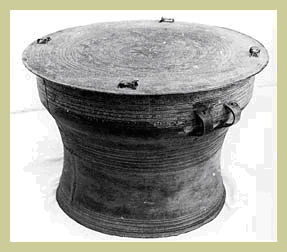 |
|
Small one-frog drum. Height 12 in., diameter of tympanum 17.5 in.
|
|
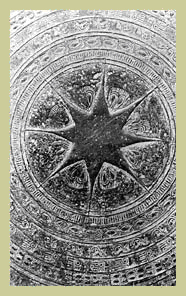 |
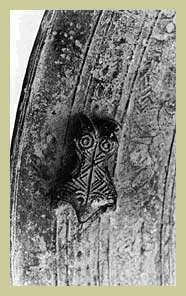 |
A close-up of the centre of the tympanum
dominated by an eight-point star with butterfly motifs between the rays.
Note the owl motif has one and a half eyes
|
This frog looks much newer than the rest of
the drum and could have b'een added much later. Frogs are placed at four
equidistant points on the perimeter of the tympanum
|
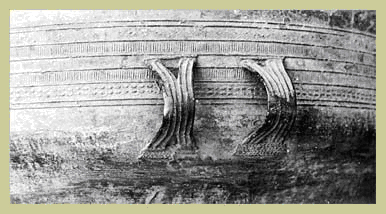 |
|
| The handles are simpler than later ones, which have more plaited designs at top and bottom |
|
A further interval of varied geometric decoration is
followed by a fairly prominent band consisting of one or two rows of
fish and large birds separated by rosettes. On the earlier drums these
rosettes are quite wheel-like. They have also been called lotuses. The
fish and birds may be single or depicted in pairs. On the earliest Karen
drums the birds are archaic, wi h some resemblance to those seen on
Type I drums and may be sitting, standing or floating.
This band may be repeated on the tympanum of some drums. On many of the later drums the birds have taken a flying posture and the fish have disappeared, to be replaced by single lozenge motifs which alternate with the rosettes. This band may be repeated up to three times on the tympanum and in some cases may fill in for the "owl" motif. Further band's of geometric decoration usually adorn the outer bands of the tympanum. The final band is generally left blank, although on some of the later drums there are a few widely spaced rosettes in this area. The perimeter is usually bounded by a thin strip of braided decoration.
This band may be repeated on the tympanum of some drums. On many of the later drums the birds have taken a flying posture and the fish have disappeared, to be replaced by single lozenge motifs which alternate with the rosettes. This band may be repeated up to three times on the tympanum and in some cases may fill in for the "owl" motif. Further band's of geometric decoration usually adorn the outer bands of the tympanum. The final band is generally left blank, although on some of the later drums there are a few widely spaced rosettes in this area. The perimeter is usually bounded by a thin strip of braided decoration.
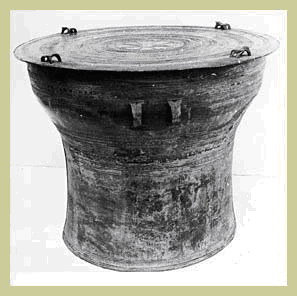 |
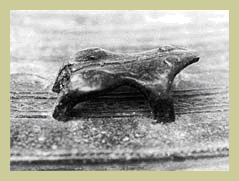
The single frog, smoothly moulded, appears to be the original
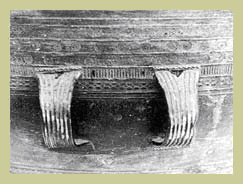
A close-up view of the strip decorated handles
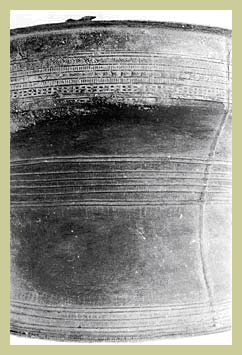
The resonance case showing one of the vertical seams and three zones of concentric circle designs.Tthe midle has been repaired
|
| One-frog drum. Height 20.5 in., diameter of tynmpanum 25 in. | |
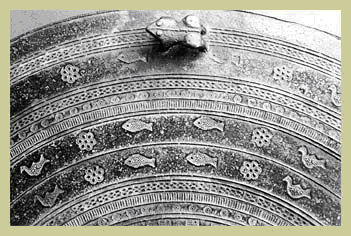 |
|
| Detail of the outer concentric bands. Pairs of fish and birds separated by six-petalled rosettes. The birds appear to be floating with one wing upraised. The fish appear to have scales. | |
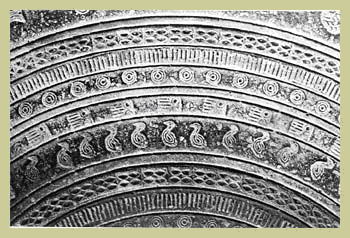 |
|
| Detail of inner concentric bands showing ducks which have become more "tear shaped", followed by owls with one and half eyes. |
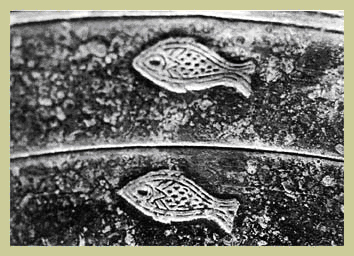 |
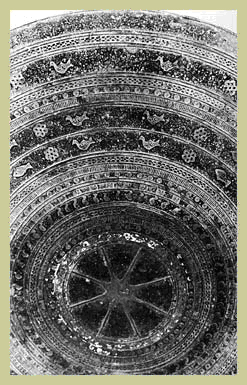
A portion of the tympanum with 17 decorated bands
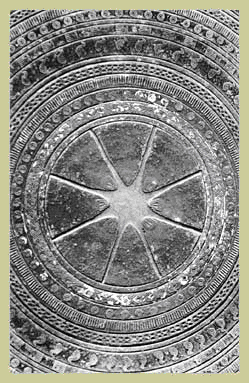
Eight-rayed filiformed star with smaller butterfly motifs between points
|
| Detail of fish on two adjacent bands of the drum's tympanum | |
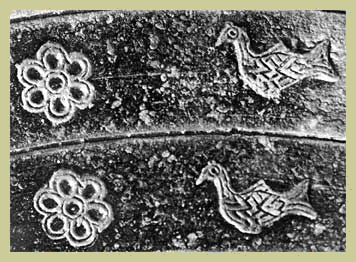 |
|
| Detail of birds and rosettes on the same bands as the fish shown above | |
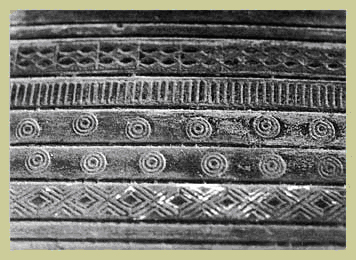 |
|
Concentric bands of decoration on the upper portion of the resonance case. Continuous lozenge, circle and dot and double chain of grain motifs. |
The design motifs on the tympanum are not always
clear because of natural wear and tear and also the failure to fill up
adequately all the finely incised lines of the mould at time of casting.
The surfaces of some drums are quite pock-marked, probably because the
mould was too hot at the time of casting. On some of the newer drums
slightly raised sprue marks are noticeable on the surface of the drum,
particularly in the area between the points of the star, for in many
cases they have not been filed level with the surface of the drum. In
some cases attempts have been made to disguise the sprues at the time of
casting by placing them on rosettes.
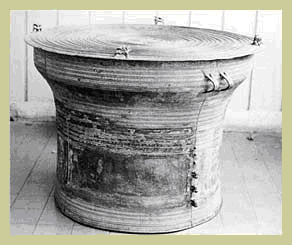 |
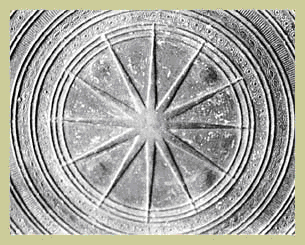 |
Two-frog drum. Height 27
inches, diameter of tympanum 27 inches. A later type of drum with two
frogs superimposed one upon the other. On base are three elephants
followed by three snails
|
Twelve-ray star at the
centre of the tympanum. There are no butterfly motifs between the
points. Note the darkened marks where the sprues were removed at each
corner of the star
|
Frogs appear at each of the four ninety-degree angles
around the perimeter of the tympanum. Like most of the animal motifs
depicted on frog drums, they face an ti-clockwise and appear to be
following each other. They are usually placed astride the last set of
concentric circles with the left feet in the last geometric band and the
right in the blank band. On the two- and three-frog drums the frogs are
superimposed one upon the other, each successive one becoming smaller.
The quality of the modelling varies greatly. As a rule the single frogs
are much more finely wrought than the superimposed examples. They may be
quite plain with protruding eyes, pointed nose, narrow waist and
spreading haunches. The backbone is usually slightly raised, resembling a
plaited line on some, while on others lines may radiate out from the
backbone like ribs. There may be spirals on the haunches.
On some drums the frogs appear to be different or much
newer than the tympanum, as indeed they may be, for protruding above the
general level of the drum, they were liable to damage. As previously
mentioned, in some cases a frog might have been removed for burial with
the deceased owner. The new owner would then replace the missing frog
with a new one.
The cylinder or resonance case with its slightly
bulging upper portion has two or occasionally four vertical seams which
are purely decorative in function. They are probably a vestigial feature
copied from Type I drums which, unlike the Karen drum, were not always
cast as a single piece, hence seams were necessary to join the drum
together. Two pairs of angular handles, usually with triangular holes at
the tops and bottom, are placed midway between the two seams on the
nether portion of the bulge at the top of the resonance case. The
handles are marked with vertical lines and occasional diamond shapes.
The handles appear to be fastened to the resonance case by a series of
plaited and zigzag lines. The handles serve not only as a device for
ease in moving the drum, but provide the means by which it was suspended
by a rope for playing with a cloth-padded bamboo stick. The drum was
allowed to swing freely a few inches above the ground. The player
steadied it while playing by hooking his toes into the handle close to
the ground.
Four to five bands of decoration adorn the bulge of the
resonance case. The circle and dot, radial rays and continuous lozenges
are the most common motifs here. The mid portion may also have seven to
eight bands of decoration often separated into two parts by a wider
band in the centre which may be left blank or may occasionally contain
rosettes. Two to four lines of geometric decoration sometimes surround
the base of the drum. Zones of decoration on the resonance case usually
end in a band of lightly impressed, closely set wavy patterns, which on
some may be in the form of a zigzag. The inner side of the resonance
case is undecorated. Scrape marks made in the process of improving the
tone of the drum are sometimes visible inside.
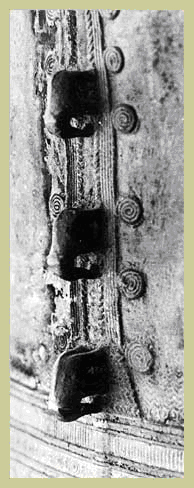
Three elephants at base of resonance case
which appear as if walking down a stylised plant. It is most unusual to
have three elephants on a two-frog drum, which strongly suggests that
the elephants were added later.
|
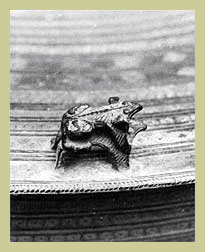 |
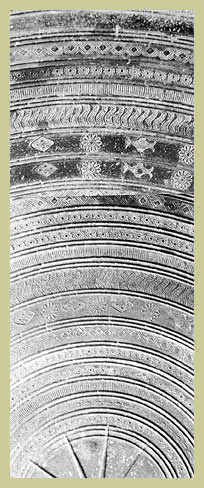
Nineteen concentric bands of the tympanum.
The circle and dot motif has become a band of small rosettes. The fish
motif has been replaced by the sing!e lozenge motif. There is no band of
owls, and the ducks appear twice.
|
A pair of superimposed frogs. Note the braiding around the perimeter of the drum
|
||
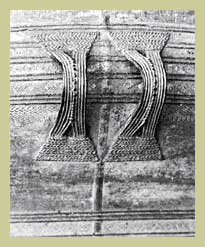 |
||
| Handles attached on either side of the seam. Note the wave-like decoration at the bottom of the decorated concentric bands |
One of the most unusual features of the Karen drum, particularly those of slightly later date, is the placing of two-dimensional plant forms and three-dimensional animals usually towards the base of the resonance case, often aligned under a pair of handles.
The most popular three-dimensional motif consists of a
procession of two or three elephants in single file, as if walking down
towards the end of the drum. The elephants are usually depicted in
conjunction with snail shells which may be placed on either side of, or
behind, each elephant. This design may be enclosed within a tree-like
form so that the elephants seem to be walking down the trunk.
The number of elephants is usually the same as the
number of superimposed frogs on the tympanum. Some drums may be
particularly elaborate, showing other flora and fauna in addition to
elephants and trees.
Newer drums may have a menagerie of fauna in the form
of squirrels, fish, reptiles, insects etc. (See Roxanna M. Brown,
"Bronze Drums of Laos", in ARTS OF ASIA, January-February 1975, the
illustration on page 53.) On a few drums the decoration may be purely
vegetal in the form of a tree or a sheaf of rice.
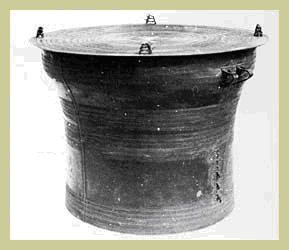 |
|
| Three-frog drum. Height 21 inches, diameter of tympanum 27 inches | |
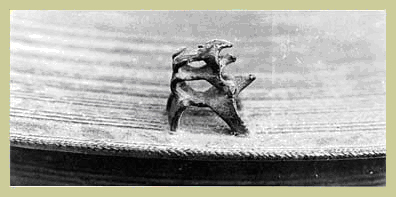 |
|
| Three frogs superimposed one upon the other, and quite crudely modelled |
|
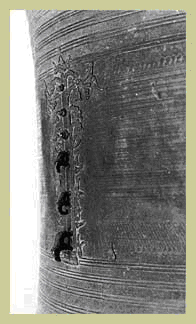 |
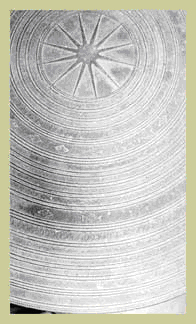 |
Detail of three elephants of diminishing sizes walking down stylised vegetation followed by three snails.
|
This tympanum is fairly typical for later drums. One unusual feature is that there are no large rosettes in the wider bands.
|
Using the internal comparative analysis method
developed by Philippe Stern and Jean Boisselier in establishing a
chronology for Southeast Asian sculpture, Dr Richard Cooler, in a
doctoral dissertation on Karen drums for Cornell University, has
attempted to trace, through a study of over four hundred drums, the
evolution of Karen drums from their Type I prototype. He has taken what
he considers to be key motifs on Karen drums - the large and small
birds, fish, owl and single lozenge-and has carefully charted their
various permutations through a series of seven evolutionary stages. The
present writer is indebted to Dr Cooler's research which has greatly
helped her to describe the general motifs and to prepare the
accompanying diagrams. Dr Cooler's research, however, suffers from the
problem that at present there are no known dateable examples of Karen
drums to provide a chronological framework on which to hang his most
interesting theories. Although Karen drums have probably been in
existence for as long as a thousand years, there are no early historical
records describing their appearance, since the Karen were not literate
until the advent of a missionary-devised script in the late nineteenth
century. Being a gentle, shy people, the Karen throughout their history
have tended to withdraw in the face of contact with other races. Until
the nineteenth century there have not been any detailed descriptions of
Karen drums from Chinese or other sources. From previously quoted
Burmese inscriptions we do know of their existence since Pagan times
(eleventh to late thirteenth centuries). According to the Rev. Harry
Marshall, none of the drums now seen can be thought with any certainty
to date further back than two centuries.
Dr Cooler in his dissertation also advances one
possible explanation for the motifs which appear on Karen frog drums. He
bases his theory on a Karen poem. He likens the tympanum of the drum to
a magic pond which expresses the Karen ideal of prosperity. The star
perhaps represents a splash with ripples in the form of concentric
circles radiating out from the centre to embrace the various elements of
an aquatic environment -birds, fish and perhaps turtles in the form of a
lozenge. He claims that the "owl" motif disappears from the Karen drum
at a particular stage of evolution because it does not fit in with the
aquatic environment. Frogs, as amphibians, are depicted close to the
perimeter of the tympanum with feet astride in the water and on the bank
where they usually spawn. An elephant is not only a status symbol for
its owner, but a beast of burden which can earn him a tidy sum by
drawing logs. Snails, considered edible by the Karen, have featured in
folklore describing the migration of the Karen people. It is hoped that
the fruits of Dr Cooler's research will eventually be published in order
to increase our knowledge and understanding of Karen drums, for few who
have seen them have failed to be fascinated by their unusual shape and
unique motifs.
With the end of the Vietnam war and the subsequent
closure of Laos to foreign contact, the export of drums from that area
has largely ceased. Although there is still a trickle of genuine drums
from Burma, there are not enough to meet the demand, and prices have
soared. From a mere US$50-I00 in Vietnam war days, a good drum in
Bangkok will cost US$IOOO-1500 today.
A number of concerns in Rangoon and Mandalay in Burma
and Thonburi and Chiang Mai in Thailand have been making reproductions
to meet the burgeoning demand. During a recent visit to Burma the
present writer had the opportunity to visit Hla Aung's bronze casting
establishment in Tanpawaddy Mandalay and managed to see part of the
casting process using the timehallowed methods already described. They
only make drums to order, usually for foreign customers and sometimes
for the Karen who still likes to use the drum for Karen New Year
festivities held annually in midJanuary. Five to six are made at a
time. A drum with a twenty-six inch wide tympanum takes about three
months to complete. To age the drum a mixture of sulphur, kerosene and
engine oil is applied to the surface. Heat may also be applied. Because
of the amount of labour and the price of the metal, a new drum costs
about US$250 in Burma. This firm makes no pretence that the drums it
produces are anything but reproductions.
Unfortunately there are a few establishments in Rangoon
and Bangkok that are less scrupulous and are known to be passing off
newly made drums as the genuine article. To determine whether a drum is
old or not, a good test is to try lifting it. If it is fairly easy to
lift, the chances are that it could be an old one. Many new ones are
very heavy and weigh up to from fifty to seventy pounds. This is because
the new drums generally have a very high lead content in the alloy
which lowers the melting point for the metal and allows it to flow more
easily into the mould with fewer mishaps. Such a drum does not have a
very good tone when struck. A real drum, if intact, will have a most
pleasing reverberating tone. The walls of the new drums are usually
thicker, whereas on the genuine ones the walls are never more than one
eighth of an inch thick. A check on the motifs will also help to
identify whether a drum is new or not. A drum with a surfeit of
archaic-type decoration combined with three-dimensional elephants and
other fauna on the resonance case is most likely to be a reproduction,
for the resonance cases of very early drums are devoid of
threedimensional decoration.
A few lighter drums have recently begun making their
appearance on the market. Instead of being cast, they have been made
from copper alloy sheeting. A careful look inside the resonance case
should reveal that the tympanum and resonance case have been soldered
together. These drums are not very sturdy and have been known to bend
and buckle easily. The tone is light and there is not much ring to it.
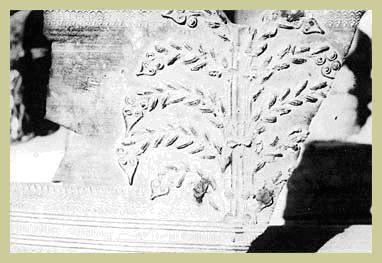 |
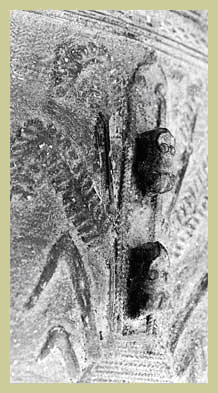
Elephants walking down a stylised rice plant
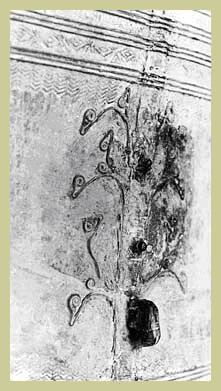 Base of frog drum showing recent repairs |
||
| Sheaf of rice at base of bronze drum fragment | |||
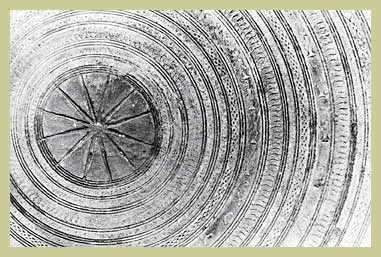 |
|||
| Tympanum of a later drum which has been extensively repaired, blurring many of the main motifs | |||
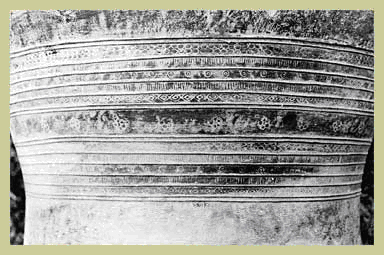 |
|||
| Central portion of a roughly restored resonance case |
A prospective buyer must also look to see whether a
drum has been extensively repaired or not, for the price should vary
accordingly. On some the tympanum and resonance case are from different
drums. A careful check on the style of motifs on each section will
reveal any discrepancies, while a look inside may show welding.
Extensive rough patches on the resonance case are also an indication
that a drum has been repaired. This may be further checked by looking
inside the resonance case for metal of a different colour and thickness.
The continuity or lack of it in the geometric designs will also alert
one to repairs.
While present-day owners of frog drums may not be aware
that their bronze ornament or side table may have been the cause of
tribal warfare or an important instrument in the ritual of Karen life,
they should rejoice in the knowledge that as the owners of such a
cherished object, they "are considered as standing higher in the
community than if they possessed seven elephants. "
22. EARLY HISTORY
Vietnam Table of Contents
The Vietnamese people represent a fusion of races, languages, and
cultures, the elements of which are still being sorted out by
ethnologists, linguists, and archaeologists. As was true for most areas
of Southeast Asia, the Indochina Peninsula was a crossroads for many
migrations of peoples, including speakers of Austronesian, Mon-Khmer,
and Tai languages. The Vietnamese language provides some clues to the
cultural mixture of the Vietnamese people. Although a separate and
distinct language, Vietnamese borrows much of its basic vocabulary from
Mon-Khmer, tonality from the Tai languages, and some grammatical
features from both Mon-Khmer and Tai. Vietnamese also exhibits some
influence from Austronesian languages, as well as large infusions of
Chinese literary, political, and philosophical terminology of a later
period.
The area now known as Vietnam has been inhabited since Paleolithic
times, with some archaeological sites in Thanh Hoa Province reportedly
dating back several thousand years. Archaeologists link the beginnings
of Vietnamese civilization to the late Neolithic, early Bronze Age,
Phung-nguyen culture, which was centered in Vinh Phu Province of
contemporary Vietnam from about 2000 to 1400 B.C.. By about 1200 B.C.,
the development of wet-rice cultivation and bronze casting in the Ma
River and Red River plains led to the development of the Dong Son
culture, notable for its elaborate bronze drums. The bronze weapons,
tools, and drums of Dong Sonian sites show a Southeast Asian influence
that indicates an indigenous origin for the bronze-casting technology.
Many small, ancient copper mine sites have been found in northern
Vietnam. Some of the similarities between the Dong Sonian sites and
other Southeast Asian sites include the presence of boat-shaped coffins
and burial jars, stilt dwellings, and evidence of the customs of
betel-nut-chewing and teeth-blackening.
According to the earliest Vietnamese traditions, the founder of the
Vietnamese nation was Hung Vuong, the first ruler of the semilegendary
Hung dynasty (2879-258 B.C., mythological dates) of the kingdom of Van
Lang. Hung Vuong, in Vietnamese mythology, was the oldest son of Lac
Long Quan (Lac Dragon Lord), who came to the Red River Delta from his
home in the sea, and Au Co, a Chinese immortal. Lac Long Quan, a
Vietnamese cultural hero, is credited with teaching the people how to
cultivate rice. The Hung dynasty, which according to tradition ruled Van
Lang for eighteen generations, is associated by Vietnamese scholars with
Dong Sonian culture. An important aspect of this culture by the sixth
century B.C. was the tidal irrigation of rice fields through an
elaborate system of canals and dikes. The fields were called Lac fields,
and Lac, mentioned in Chinese annals, is the earliest recorded name for
the Vietnamese people.
The Hung kings ruled Van Lang in feudal fashion with the aid of the
Lac lords, who controlled the communal settlements around each irrigated
area, organized construction and maintenance of the dikes, and regulated
the supply of water. Besides cultivating rice, the people of Van Lang
grew other grains and beans and raised stock, mainly buffaloes,
chickens, and pigs. Potterymaking and bamboo-working were highly
developed crafts, as were basketry, leather-working, and the weaving of
hemp, jute, and silk. Both transport and communication were provided by
dugout canoes, which plied the network of rivers and canals.
The last Hung king was overthrown in the third century B.C. by An
Duong Vuong, the ruler of the neighboring upland kingdom of Thuc. An
Duong Vuong united Van Lang with Thuc to form Au Lac, building his
capital and citadel at Co Loa, thirty-five kilometers north of
present-day Hanoi. An Duong's kingdom was short-lived, however, being
conquered in 208 B.C. by the army of the Chinese Qin dynasty (221-207
B.C.) military commander Trieu Da (Zhao Tuo in Chinese). Reluctant to
accept the rule of the Qin dynasty's successor, the new Han dynasty (206
B.C.-A.D. 220), Trieu Da combined the territories under his control in
southern China and northern Vietnam and established the kingdom of Nam
Viet (Nan Yue in Chinese), meaning Southern Viet. Viet (Yue) was the
term applied by the Chinese to the various peoples on the southern
fringes of the Han empire, including the people of the Red River Delta.
Trieu Da divided his kingdom of Nam Viet into nine military districts;
the southern three (Giao Chi, Cuu Chan, and Nhat Nam) included the
northern part of present-day Vietnam. The Lac lords continued to rule in
the Red River Delta, but as vassals of Nam Viet.

Custom Search
Source: U.S. Library of Congress
countrystudies.us/vietnam/3.htm
23. The bronze drums of Dongson - Alloying and casting technologies
By Pham V. Huong, Arts and Literary E-Magazine,
No. 478, 22 August 1999
After the fourth century BC, other drums of bronze continue to be
manufactured. One finds several of them even in Ngoc-lu and at other
regions of the Southeast-Asia, attesting the blossoming of this
culture that archaeologists later call Dongson culture.
3.1.5. Bronze drums of Post-Dongson period
After having seen the ties existing between the metallurgy science of
the period meadow-Dongson and the one of the Dongson period as well as
the casting technique, it would be interesting to examine bronze drums
of the post-Dongson period in order to follow their evolution.
The results of the micro-analysis of the X-ray spectra concerning a
bronze drum of the fourth century of our era are given in the next
table.
We can notice that the tenure of Lead is weaker than in the drum of
Ngoc-lu. One also note that the decorations on the drum are a lot
simpler and especially much less fine. Let's recall that this
geographical area underwent from the beginning of the second century
BC a crushing influence Han coming of the center of continental China.
One would be able therefore to deduce that a tenure of lead around 16%
in atomic percentage in the alloy, as the one used at the dongsonian
time, would facilitate the thin motive casting in relief.
On the other hand, the absence of Iron can be noticed. This absence
could be owed to the absence of Ion foulness in the ores of origin,
either to a more worked out alloying science, due to the knowledge in
the 4th century of purification and obtention of pure metals Copper,
Tin and Lead before their recombination in alloy. We bend toward this
second explanation.
In this optics, an alloy containing equal parts in weight of the three
metals Cu, Sn and Pb, without Fe, would be therefore adequate for the
casting of objects with fine decorations in relief.
3.2. Bronze drums and geographical variances
When one examines bronze drums overdrafted in different regions since
Mianmar until Indonesia, while passing by the south of China and
Vietnam , one notes no without surprise that the drums carry all same
motives of decoration 21. On the center of the eardrum there is always
a stellar motive being able to represent the place of percussion with
radiuses symbolizing directions of resonant propagation. Men and women
carrying clothes and long feather hats are represented on crowns of
the eardrum. Birds with long beak and long tail follow each other on
other crowns. These motives are strangely the same whatever is the
geographical origin of the drums.
Besides, many drums carry on the periphery of their eardrum toads by
group of four either superimposed of four are called MALE DRUMS
everywhere (tro^'ng in Vietnamese). Those not carrying a toad are said
FEMALE DRUMS.
This identity of the visible decorations on the outside contrasts with
the difference of the chemical compositions of the alloy (inside) of
the drums, according to the geographical regions as we already saw it
above. This fact could explain himself by the nature of the cultural
exchange between peoples of the Southeast-Asia of the proto-history
22-28. If the apparent decorations were easily transferable, the
metallurgy science was certainly kept in secret by smelters craftsmen
of every region. MANUFACTURES OF BRONZE DRUMS WERE THEREFORE LOCAL.
4. Conclusion
X-ray Micro-spectroscopy and Raman Micro-spectroscopy were used to the
studies of bronze drums of the first millennum before our era, and
overdrafted in Southeast-Asia. The analysis of the results permitted
to understand the alloying science and the casting technique of these
hollow objects of big sizes and including particularly thin motives of
decoration. The study also reflects a particular nature of the
cultural exchange at the proto-historic time between peoples of this
region. The undertaken analytic procedure would be perfectly
applicable to some other problems that can raise by archaeology.
REFERENCES
1. Heger F. Alte Metalltrommels aus Sudost Asien. Leipzig, 1902.
2. Bayard D.T. A Checklist of Vietnamese Radiocarbon Dates. in Southeast Asean Archaeology. Bayard D.T. Ed., University of Otago, 1984, Nº 16.
3. van Callenfels P, The Age of the Bronze Kettledrums. Bull. Raffles Museum. Singapore 1937, B1, 150.
4. Von Dewall M, in Early South-East Asia, Smith R.B., Watson W., Eds, Oxford University Press, Oxford/New york 1979, 137.
5. Karlgren B., The Date of the Early Dongson Culture, Bull. Museum of Far Eastern Antiquities, 1942, 14, 1.
6. Goloubew V., Bull. de l'Ecole Franc. d'Extreme Orient, 1929, t. 29. et 1940, t. 40.
7. Heine-Geldern R., Research on South-East Asia, American Anthropologist, New York, 1966, nº4.
8. Higham C. The Archeology of Mainland Southeast Asia, Cambridge University Press, Cambridge 1989.
9. Jansen O., Archaeological Research in Indochina. Inst. Belge des Hautes Etudes Chinoises, Bruges 1958.
10. Ha van Tan (Ed), La Culture Dongson au Vietnam, Sciences Sociales, Hanoi, 1994.
11. Pham Minh Huyen, Nguyen van Huyen, Trinh Sinh, Les Tambours de Dongson, Sciences Sociales, Hanoi, 1987.
12. Chu van Tan, Khao co hoc, 1989, 1, 49.
13. Diep dinh Hoa, New Archaeological Discoveries, Hanoi 1985 and 1992.
14. Loofs-Wissowa H., The Development and Spread of Metallurgy in Southeast Asia, J. Southeast Asian Studies, 1983, 14, 1.
15. Murowchik R.E., The Development of Early Bronze Metallurgy in Vietnam and Kampuchia. in The Beginning of the Use of Metals and Alloys, Maddin R. Ed. MIT Press, Cambridge, 1988.
16. Solheim W.G., The Development of Metallurgy in Southeast Asia. J. of Southeast Asian Studies, 1983, 14.
17. Ha van Phung, Khao co hoc, 1981, 3, 44.
18. Pham V. Huong, in Analytical Raman Spectroscopy, Grasselli J. & Bulkin B., Eds, Wiley, New York 1991, 151.
19. Pham V. Huong, Fresenius J. Anal. Chem. 1996, 355, 596.
20. Pham V. Huong, Vibrational Spectroscopy, 1996, 11, 17.
21. Parmentier H., Anciens Tambours de Bronze, Bull. de l'Ecole Franc. d'Extr=EAme Orient, 1932.
22. Peacock B.A.V., Two Dongson Drums from Kuala Trengganu, Malaysia in History, 1967, 10, Nº2.
23. Pearson R., Dongson and its Origin, Bull. of the Institute of Ethnology, Academia Sinica 1962, 13, 27.
24. Pham V. Huong, Les Tambours de Bronze du Sud-Est Asiatique. Revue de Geographie, Bordeaux, 1996, 196, 423.
25. Bezacier L. Le Vietnam de la Pr=E9histoire, Paris, 1972.
26. Bernet-Kempers A.J. The Kettledrums of Southeast Asia. in Modern Quaternary Research in Southeast Asia. 1986, Nº 10.
27. Groslier B.P. Indochine: Carrefour des Arts, Paris 1961.
28. Jansen O., Vietnam: Carrefour de Peuples et de Civilisations, France-Asia, 1961, 165.
29. Pham van Huong, J-L. Bruneel, M. Lahaye,
http://www.hartford-hwp.com/archives/54/178.html
2. Bayard D.T. A Checklist of Vietnamese Radiocarbon Dates. in Southeast Asean Archaeology. Bayard D.T. Ed., University of Otago, 1984, Nº 16.
3. van Callenfels P, The Age of the Bronze Kettledrums. Bull. Raffles Museum. Singapore 1937, B1, 150.
4. Von Dewall M, in Early South-East Asia, Smith R.B., Watson W., Eds, Oxford University Press, Oxford/New york 1979, 137.
5. Karlgren B., The Date of the Early Dongson Culture, Bull. Museum of Far Eastern Antiquities, 1942, 14, 1.
6. Goloubew V., Bull. de l'Ecole Franc. d'Extreme Orient, 1929, t. 29. et 1940, t. 40.
7. Heine-Geldern R., Research on South-East Asia, American Anthropologist, New York, 1966, nº4.
8. Higham C. The Archeology of Mainland Southeast Asia, Cambridge University Press, Cambridge 1989.
9. Jansen O., Archaeological Research in Indochina. Inst. Belge des Hautes Etudes Chinoises, Bruges 1958.
10. Ha van Tan (Ed), La Culture Dongson au Vietnam, Sciences Sociales, Hanoi, 1994.
11. Pham Minh Huyen, Nguyen van Huyen, Trinh Sinh, Les Tambours de Dongson, Sciences Sociales, Hanoi, 1987.
12. Chu van Tan, Khao co hoc, 1989, 1, 49.
13. Diep dinh Hoa, New Archaeological Discoveries, Hanoi 1985 and 1992.
14. Loofs-Wissowa H., The Development and Spread of Metallurgy in Southeast Asia, J. Southeast Asian Studies, 1983, 14, 1.
15. Murowchik R.E., The Development of Early Bronze Metallurgy in Vietnam and Kampuchia. in The Beginning of the Use of Metals and Alloys, Maddin R. Ed. MIT Press, Cambridge, 1988.
16. Solheim W.G., The Development of Metallurgy in Southeast Asia. J. of Southeast Asian Studies, 1983, 14.
17. Ha van Phung, Khao co hoc, 1981, 3, 44.
18. Pham V. Huong, in Analytical Raman Spectroscopy, Grasselli J. & Bulkin B., Eds, Wiley, New York 1991, 151.
19. Pham V. Huong, Fresenius J. Anal. Chem. 1996, 355, 596.
20. Pham V. Huong, Vibrational Spectroscopy, 1996, 11, 17.
21. Parmentier H., Anciens Tambours de Bronze, Bull. de l'Ecole Franc. d'Extr=EAme Orient, 1932.
22. Peacock B.A.V., Two Dongson Drums from Kuala Trengganu, Malaysia in History, 1967, 10, Nº2.
23. Pearson R., Dongson and its Origin, Bull. of the Institute of Ethnology, Academia Sinica 1962, 13, 27.
24. Pham V. Huong, Les Tambours de Bronze du Sud-Est Asiatique. Revue de Geographie, Bordeaux, 1996, 196, 423.
25. Bezacier L. Le Vietnam de la Pr=E9histoire, Paris, 1972.
26. Bernet-Kempers A.J. The Kettledrums of Southeast Asia. in Modern Quaternary Research in Southeast Asia. 1986, Nº 10.
27. Groslier B.P. Indochine: Carrefour des Arts, Paris 1961.
28. Jansen O., Vietnam: Carrefour de Peuples et de Civilisations, France-Asia, 1961, 165.
29. Pham van Huong, J-L. Bruneel, M. Lahaye,
Etude des tambours de bronze de Dong son, Spectra Analyse, 1998, 201, 25.
http://www.hartford-hwp.com/archives/54/178.html
24. Ban Chiang Culture And Dong Son Culture History Essay
For the origin of the metalwork in Southeast Asia, there were many
different opinions of the scholars. Some scholars support that the
metalwork in Southeast Asia was origin locally and some of them support
that it was from India and China. But unluckily, there is not enough
evidence to prove which of them would be the truth. Therefore, the
origin of the metalwork in Southeast Asia is not clear and uncertain.
Compare with the Ban Chiang culture, the Dong son culture was
appeared later in Southeast Asia. The Dong son was also one of the
flourishing cultures during Bronze and Iron Age period in Southeast
Asia.
In geography, the center of the Dong son culture was located in the
Red river valley at the North Vietnam. It was named by the village where
the archeologists had found. The Dong son culture was not form
independently and it was probably developed from the local Neolithic
cultures at Vietnam such as the Dong dau.
Different to the Ban Chiang, there was the monarch kingdom (Văn Lang
and Au Lac) appeared in Vietnam. The Dong son people did trade in
Southeast Asia and also China and India by sea, it made the Dong son
culture was influenced and transformed by the Indian and the Chinese. In
43 AD., the Dong son was occupied and rude by the Han dynasty in China.
The characteristic of the Dong son culture was the bronze object with
the high level craftsmanship. Till the Dong son period, the people
mastered the technology and skill of the bronze making, they used the
metals to make many different kind of metal tools. The metallurgy and
the bronze making was in a very high level, and they developed their own
sophisticated metallurgy techniques based on the special quality of the
bamboo and they were able to use the bamboo to fashion a fire-piston
that produced the heat required to liquefy metal. [1]
The Dong son people used the metal tools in their life, especially
the bronze. They used the bronze in making the agricultural tools such
as the ploughshare, axe, spade, sickles and hoe etc, (few of them were
made by iron) it reflected that the agriculture was high developed in
Dong son and the ploughshare was the typical agricultural bronze tools
in this culture, it showed and proved that the Dong son people had
already domesticated and used the water buffalos’ strength in their
agricultural activities.
Besides the agricultural tools, many weapons were found in the relics
of the Dong son culture. It might reflect that there were wars happened
in this region. There were various of weapons were found and it
included the arrows, axe, daggers, spears, swords and breastplates etc.,
different kind of these weapons showed that the military technology of
the Dong son people was quite completed. On the other hands, the weapons
were rich of decorative patterns, those patterns were vividly and
detailed. The weapons were made in many different shape and the patterns
was usually animals and human figures, it represented that the
metallurgic technology of the Dong son people was very sophisticated and
we can also see what the Dong son people looked like from the patterns.
Not only metals, the Dong son people also used the potteries as the
utensil for their daily life. The jars, pots, basins, vases and jugs
with the decorative patterns were found in the Dong son relic. Some of
these utensils found in the relic of burial were filled with the jewelry
and even the skull, ash, human bones and remains of the dead people.
This relic told us that the pottery jar was not just used for utensil,
it was also used as the coffin in the funeral.
In the relic, the archeologists found abundant of the jewelry. This
jewelry was mainly made of bronze and there were other materials such as
the gemstones, glass, iron and shells etc. Some of the ankles rings
were decorated with the small bell and it would made sound when people
move. It represented that not only for the dead people, the people alive
were like to have the jewelry for making themselves more attractive.
Except for the pottery and jewelry, there were musical instruments
found in the relic. It reflected that the spiritual life of the people
and the most representative musical instruments was the Dong son bronze
drum. The usage of these drums was still uncertain (it might be used for
religious, celebrations or regalia) but many evidences prove that the
drums were traded as the goods in China and the Southeast Asia. The ship
pattern on the drum might showing the trading activity and the star on
the center of the tympanum might represent the mandala polity. Many of
the patterns on the drums were seems showing the spiritual life of the
people and the style of the drums were different in different regions.
Some of the drums were huge and it made by the lost wax method, it made
the pattern could be in more detail and showing the sophisticated of the
metallurgic of the Dong son people.
In conclusion, there was difference of the metal work and used
between the Dong Son and the Ban Chiang culture. The Ban Chiang appeared
earlier than the Dong son and its metal work was simple and mostly for
the practical use. The Ban Chiang also used the bimetallic (bronze and
iron) in the tools and iron in burial. Different to the Ban Chiang, the
metallurgy of Dong son was more sophisticated and they used the lost wax
method in the metal works. The skillful technology made the Dong son
bronze working became diversification and many of the Dong son relics
was in more detail than the Ban Chiang. The Dong son drums showing the
trading activity and there was regalia of the Dong son people, it is
very different to the Ban Chiang. The different style of the drums
reflected that there were contacts between the regions and the metal
working (lost wax method) skill was spread in Southeast Asia. The
jewelry and different kind of the funeral of the Dong son showing that
the Dong son society was more complicated than the Ban Chiang and there
might have the social stratification in the Dong son society.
25. The distribution of bronze drums of the Heger I and Pre-I types
The Distribution of Bronze Drums of the Heger I and Pre-I
(page 29)
ABSTRACT
Based
on the chronological sequence and temporal division of bronze drums
published in 1993, the changes in their distribution throughout Southern
China and Southeast Asia are examined.
The chronology proposed in 1993 divided the bronze drums of the Heger I type into six phases: 1a, 1b, 2a, 2b, 3a and 3b. Since these small divisions leave many drums for which there is insufficient information unclassified, a rather rough division into phases 1, 2 and
3, plus phase 0 for the Pre-Heger I type, is also used.
The drums of phase 0 (4th~ 3rd c. B.C.) concentrate in Southern China and Northern Vietnam. Phase 1 (3rd- 1st c.B.C.) shows a similar distribution, with partial expansions into the peninsular area of Thailand and the island of Java in Indonesia. In the next phase, 2a (1 st c. B.C.), the bronze drums disappear almost completely from Southern China.
Although Vietnam retains a fair number of drums, there are fewer large drums. In contrast to this situation in the northern areas, the southern areas of Southeast Asia witness an increase in number. There is a special phenomenon where particularly large drums concentrate on small islands of Eastern Indonesia. In phase 2b (1st c. A.D.), drums of the Dong Son tradition diffuse into the vacancy left by the Shizaishan tradition in Southern China, where it had disappeared; hence, Guangxi Province becomes the area with the densest distribution in phase 3b (2nd c. A.D. and after). Around this time, drums that are in the process of changing to the Indonesian Pejeng type, though very few in number, are seen in the southern areas.
Regarding the historical background, bronze drums disappeared temporarily in phase 2a in China and diffused into the southern part of Southeast Asia soon after the conquest of Southern China and Northern Vietnam by the Han Empire and as a direct consequence of this invasion.
The changes in the distribution of bronze drums reveal that prehistoric Southeast Asia was not a gathering of small, isolated worlds, but rather a network of mutually linked areas more or less in unison.
Types:
Temporal Changes and Historical Background
Keiji Imamura
1. Outline of the Pre-Heger I and Heger I types
1-a. Signifi cance of bronze drum research
Bronze drums have been reported plentifully, widely, and with precision * more so than any other*
-------
*The information of bronze drums for this paper was mostly taken from the following books.
Pham Huy Thong et al. 1990.
Dong Son Drums in Viet Nam.
The Vietnam Social Science Publishing House.
Kempers, A.J.B. 1988.
The Kettledrums of Southeast Asia.
Modern Quaternary Research in Southeast Asia vol.10.
Chinese Association for the Study of Ancient Bronze Drums 1988.
Ancient Chinese Bronze Drums.
Cultural Relics
Publishing House, Beijing.(in Chinese)
Museum of the Guangxi Zhuang Nationality Autonomous Region 1991.
Illustrated Catalog of Guangxi Bronze Drums.
(in Chinese)
National Museums and the Fine Atrs Department 2003.
The Bronze Kettle Drums in Thailand.
Bangkok.
Per Sørensen(ed.)1988.
Archaeological Excavations in Thailand
Surface finds and minor excavations
Scandinavian
Institute of Asian Studies, Occasional Papers no.1. Curzon Press Ltd., London.
Pham Minh Huyen 1997. Dong Son Drums discovered in Lao Cai Town in1993.
Journal of Southeast Asian Archaeology no. 17.
____
30. Keiji Imamura
archaeological material in Southeast Asia. This situation enables us to examine the late prehistory and early historic times of a vast geographical area which extends from Southern China down to the southernmost parts of Southeast Asia, via one kind of artifact. This is one of the significances of bronze drum research.
1-b. Distribution research and temporal division
When we try to glean the historical implications behind the distribution of any kind of artifact,
maps
should be drawn according to the shortest possible temporal phases.
Historical processes are hardly recognizable on maps which account for
long durations, since such maps show an accumulation of phenomena
occurring during long stretches of time. It is generally difficult to
classify artifacts distributed across an extensive area into short
phases. In the case of bronze drums, however, this can be done fairly
easily, because they possess many common traits despite their wide
distribution.
1-c. Several traditions in the early bronze drums (Figs.1, 2)
Bronze
drums have a wide range of shapes and decorations. However, by no means
do they bear random combinations of traits. When we trace the changes
in form and the lineage of each kind of decoration, and when we check
which kinds of traits are seen together on each drum, we find that each
drum can be placed at its own point in a precise sequence of changes.
Among the early bronze drums, three important sequential traditions are
recognized.
They are the Pre-Heger I
(Imamura1973), Shizaishan and Dong Son (Imamura 1993) traditions. There
are also rare specimens that can hardly be placed in any of these
traditons. Let us first present an outline of the typological and
distributional changes in order to facilitate the reader’s understanding
of the topic.
Bronze drums of the Pre-I type were
produced by turning bronze cauldrons upside down (Imamura1973); they
were distributed in Southern China and Northern Vietnam during the
earliest phase (phase 0, from the 4th to the 3rd century B.C.). They
underwent a sequential development, basically from plain drums into
drums with many decorative patterns on the surface
(Imamura1979). Although the cauldrons also changed their form, they remained plain.
The Shizaishan tradition of the Heger I type evolved from the Pre-I type through intermediate
instances. These maintained almost the same dis-tributional areas (i.e.,
Southern China and North-ern Vietnam), although a few rare specimens have been found
in Thailand and on the island of Java in Indonesia. This tradition disappeared
as early Fig.1
as the 1st century B.C. After this, Southern China experienced a short
period with few bronze drums (Imamu- ra1993).
The origin of the Dong Son tradition of the Heger I type is not clear. Its
early stage is known to have been
contemporaneous with the Shizaishan tradition, and its bronze drums were
distributed mainly throughout Northern Vietnam. Before long, many drums of this
tradition diffused into the southern parts of Southeast Asia, such as Thailand,
the Malay Peninsula and Indonesia. This southward expansion occurred in the 1stcentury
B.C. and will be discussed later. A local tradition developed soon in the
southern portion of Southeast Asia, and seems to have continuously changed into
the Pejeng type in Indonesia, although the existence of this link has not been
proven to date by actual intermediate specimens.
For the period beginning with the 2nd century A.D., or in the final
stage of the Heger I type, there are fewer finds in the southern part of
Southeast Asia. Their distribution becomes concentrated once again in Northern
Vietnam and China’s Guangxi Province. This revival of bronze drums in Southern
China did not belong to the Shizaishan tradition, but was an expansion of the
Dong Son tradition from Northern Vietnam, where it had been maintained
(Imamura1993).
Several centuries later, the last drums of the Dong Son tradition evolved
into the Heger II type, and also onto an intermediate type between Heger I and
IV. A few specimens from Thailand and Myanmar show that the last drums of the Heger I type evolved
there into the Heger III type (Cooler1995).
Fig.2
Genealogical chart of bronze drums and temporal divisions of Dong Son
tradition
Main traditions of early bronze drums
The distribution of bronze drums of the Heger I and Pre-I types bands of the
Dong Son tradition in Vietnam into a precise temporal order. This tradition can
be divided into six phases, 1a, 1b, 2a,
2b, 3a and 3b, according to several indicative patterns and other features
(Fig.3).
Among the Dong Son tradition drums with a single pictorial band, only the
drums with patterns or traits common to those of drums with multiple pictorial
bands can be classified into the same six phases, but the ones without such
clues can only be roughly correlated. As for the drums of the Shizaishan
tradition, their temporal positions can be estimated according to the traits
common to the Shizaishan and the Dong Son traditions or based on the
co-existence in one tomb with Dong Son tradition drums. Many Shizaishan drums cannot
be precisely correlated to the six phases of the Dong Son tradition. However,
this does not cause a big problem, because the tradition lasted only for a
short time, mostly during the 1a and 1b phases. This is one of the reasons why
I will not use the above-mentioned 6 phases, but three rougher phases (1, 2 and
3) when I will show some distribution maps later.
In phase 2b, the number of drums with a single pictorial band decreases and,
in phases 3a and 3b, they disappear, leaving only drums with multiple pictorial
bands.
3. Dates (Fig.8)
The causes that led to the change in the distribution of bronze drums will
be discussed later. Possible causal historical events can be pointed out only
after the calendar years for each phase are given. For the date of Pre-I drums,
the Tiandong drum of Guangxi Province is important, because it was found
together with a bronze jar of the Warring States period (Chen et al.1993) and
is dated around the 4th century B.C. There are many pieces of evidence which point to the 2nd
century B.C. for the Shizaishan type.
The Dong Son tradition, although important as the axis of our relative
chronology, provides insufficient data for determining the calendar years. One
phase 1b specimen has been unearthed from a tomb in Guangxi dating back to the
2nd century B.C (Museum of the Guangxi Zhuang Nationality Autonomous
Region 1988).
At the Phu Chanh site in the Binh Duong province of Vietnam, a Western Han
mirror dating from the final phase of the dynasty, i.e. around the start of the
Christian Era, was excavated together with a phase-2a bronze drum from one tomb
(Yamagata et al. 2001).
One phase-3b specimen bears the inscription “199 A.D.” on its surface
(Loewenstein, J. 1956). There is scant dating evidence stemming from between
the last two points of time. A Chinese bronze basin which has been indirectly
dated at about 100 A.D. (Yoshikai1995) has patterns of flying birds and
feathered people, which are degenerated compared to the same kinds of patterns found on
phase-2b drums. So, we can estimate the boundary between phases 2b and 3a to be
a little earlier than 100 A.D. On the ground, we can estimate the boundary
between phases 2a and 2b to be a little later than the beginning of the
Christian Era; accordingly, most of phase 2a must have lasted no later than 42 A.D.,
the year of General Ma Yuan’s suppression of the any amendments. A revised
paper will be published after the new information becomes available.
2. In this paper, judging from the typological sequences, I wrote that the
large drums of Eastern Indonesia were pro-duced in Vietnam, in spite of the
fact that similar large specimens have not been not discovered there. At the
2006 congress of the IPPA, however, Dr. Pham Minh Huyen reported on the newly
discovered Hoa Binh drum, which is 107
cm in diameter and known to belong to phase 2b on her photographs. The Le Quang
Chuc drum which Dr. Ambra Calo reported at the same conference was the same
piece. This discovery proved that very large drums were actually produced in
Vietnam during phase 2.
3. Like a criticism to my paper by an attendee at the IPPA conference, it is
rather common idea in Chinese archaeol-ogy to push the original date of my
Pre-I type (Wanjiaba type for Chinese archaeologists) bronze drums back to the
6th-7th century B.C., depending on the results of C14 dating. Such early dates
are questionable, because the C14 dates,
which are inherently inaccurate to some degree, do not fit the recognized process of history in
detail, and because the calibration curve of C14 dating is so flat between the
calendar years 400 and 700 B.C. that it gives roughly the same C14 dates. Such
dates cannot be converted back to calendar years, and means that objects
stem-ming from the period between 400 and 700 B.C. cannot be precisely dated by
the C14 method
26.
View from the East Mountain: An Examination of the Relationship between
the Dong Son and Lake Tien Civilizations in the First Millennium B.C.
Received 2 July 1989
JOHN TESSITORE
THE DONG SON ("East Mountain") Bronze Age culture of the Red River delta of northern Viet Nam has been known since the 1930s. The original finds date to the colonial period and were handsomely described by Goloubew (1929, 1937) and Janse (1958). They include the now familiar and characteristic bronze drums and weapons, burial situlae (bucket-shaped ceramic and bronze vessels), and concentric decorative motifs. Subsequent research, including a plethora of recent work by the Vietnamese themselves (Hoang and Bui 1980), reveals the Dong Son cultural complex as a
northern center of a widespread bronzeliron complex found throughout Viet Nam and the rest of Southeast Asia. It represents an in situ development from preceding Neolithic phases in the vicinity of the Red, Ma, and Ca river systems.Between 1955 and 1960, 50 tombs were discovered at Shizhai Shan, Jinning, in Yunnan Province (Fig. 1). This far-distant region was known as the kingdom of Tien during the western Han period (206 B.C.-A.D. 9). The archaeological investigations revealed a rich Bronze Age culture with multiform affinities, including some with the roughly contemporaneous Dong Son to the southeast. Continuing excavations in Yunnan and western Sichuan have greatly expanded both the geographical and material cultural bases of Tien society, but its relationships to contemporary first-millennium B. c. chiefdoms and states in northern Southeast Asia remains hazy.
The purpose of this paper is to systematically explore the links between the Lake Tien complex in Yunnan Province and the Dong Son cultural complex of northern
Viet Nam.
NORTHERN VIET NAM
The Red River delta in northern Viet Nam has been the subject of much speculation
regarding indigenous political development. Traditional views, based largely on
John Tessitore is a graduate student, Department of Anthropology, University of Hawaii, Manoa.
Asian Perspectives Vol. 28, no. 1. © 1990 by University of Hawaii Press. All rights reserved.
32
....
: .....
Asian Perspectives XXVIII (1), 1988-1989
....... . "~
C H (..i I N A ." .. ' .:.~:,.~;.>·r' '.
"';:" KWEICHOW/ .. ·,,···
: ... '~:: ..................... / ............ .
.... : ..
::"'-'
KWAN<=rSI
.""'- GULFO OF
TONKIN
.
.A THAILAND
Fig. 1. Viet Narn and neighboring countries.archaeological work done during
the French colonial period, held that Viet Nam had a primitive level of culture
at the time that it was successfully annexed by China in the first century
A.D., or that it was basically a loan culture, learning agriculture and metalworking
from outside sources. More recent archaeological work, however-in addition to a
concerted effort on the part of Vietnamese historians, folklorists, and
TESSITORE: VIEW FROM THE EAST MOUNTAIN 33
archaeologists to seek political-cultural roots that antedate the Han
period-has resulted in an interpretation of early state development that
correlates legendary beginnings with hard physical evidence (Pham Huy Thong
1983).Q'Harrow (1979: 140) argues that ethnohistory and archaeology must be at
each other's service to provide a reasonable historical outline of Vietnamese
society leading up to the first extensive imposition of Chinese power in the
area in the first century B. c. He coins the term Proto- Vietnamese in
reference to the group or groups of Yueh people in the Red River delta and its
environs, stretching northward into southern Guangdong and Guangxi and
southward through coastal Thanh Hoa Province
(142). They are the people who share the material culture illustrated by
Dong Son and related finds-a people who were the heirs, in the second half of
the first millennium B. C., to the antecedent neolithic Phung Nguyen Culture,
and whose domain appears to have been congruent with the protohistorical state
of Van Lang. The Phung Nguyen Culture is divided into three periods-Phung
Nguyen, Dong Dau, and Go Mun-which commence as early as 3000 B.C. and terminate
in the first half of the first millennium B. c. The first half of the culture
has an elaborate stone technology, ornaments of jadeite, weaving, and
elaborately decorated wheel thrown pottery; many of the geometric decorations
appear ancestral to the later Dong Son motifs. By the second Inillennium B.C.,
bronze metallurgy was well developed, with artifact types and techniques
similar to material from northeast Thailand (Bayard 1980: 97). Phung Nguyen
sites are distributed over a large area that includes the plains and part of
the mountains; they concentrate densely at the intersection of the Red and Black
rivers at Hac Tri, just north of Ha Noi. So far over 30 sites have been
identified. Rice grains and the bones of pigs, chickens, and cattle dating to
the third millennium B. C. have been recovered. That these animals were
probably domesticated is further indicated by the presence of baked clay
figurines of cattle, dogs, pigs, and chickens in the archaeological assemblage
(Nguyen B. K. 1980:27-44; Hoang and Bui 1980:56-57).
Perhaps the most important thing about Phung Nguyen culture is the evidence it
affords for the indigenous beginnings of Vietnamese civilization. Previously
the traditional kingdom of Van Lang (2800-700 B.C.) and the Vuong Hung dynasty (700-258
B.C.) were viewed as legendary. The Phung Nguyen sites, which coincide with the
Me Linh region attributed to the kingdom, give archaeological support for the
presence of an advanced society in the area well before the Chinese contacts of
the second and first centuries B. c. While the dates of the kings are subject
to question,they nevertheless overlap with the dates assigned to the culture
complex.
Nguyen Ba Khoach (1980:47-49) suggests that in all likelihood the formation,
development,
and end of the kingdom of Van Lang ranges somewhere along the continuum from late Phung Nguyen to Dong Son (1100-300
B.C.).According to the Vietnamese origin myth (recorded in the fifteenth
century), Van Lang was ruled by the Hung kings, who claimed descent from Lac
Long Quan (Lac Dragon Lord), a hero who came to the Red River plains from his
home in the sea; he subdued all evil demons in the land and civilized the
people, teaching them to cultivate rice and to wear clothes. Lac Long Quan and
Au Co (wife of an intruder from the north) are regarded by the Vietnamese as
the progenitors of their race. In another version, the oldest son of Au Co's 50
children was chosen to be king of the country of Van Lang. The country was then
divided into 15 sections, with a brother of the king governing each section.
34 Asian Perspectives XXVIII (1), 1988-1989
Taylor (1983: 3), citing a Vietnamese study, suggests that the name Hung
derives from an Austroasiatic title of chieftainship, while Van Lang is
associated with phonetically similar words that mean "people" and, by
extension, "nation." Thus the legend may not represent the history of
a single dynasty or kingdom so much as the consolidation of clans or tribes
into chiefdoms. According to Wheatley (1983: 11), "chiefdoms exhibit in
their respective degrees relatively permanent, centralized leadership and
hereditary hierarchical status arrangements informed by an aristocratic ethos."
The archaeological evidence for the Phung Nguyen through Dong Son periods
suggests an evolution from a communal life built up from aggregations of clans
and tribes to a more hierarchical society based on relatively small village or family
groups. Grave sites from the Dong Son period, rich with bronze burial goods,
indicate that clear distinctions existed in society between the ruling class
and the ruled. It is this period of society, at a level of political
integration based on supralocal ties and at least some degree of hierarchy,
that Vietnamese scholars identify as the time of the Hung kings and the kingdom
of Van Lang.
===
.
Nguyen Ba Khoach (1980:47-49) suggests that in all likelihood the formation, development,
and end of the kingdom of Van Lang ranges somewhere along the continuum from late Phung Nguyen to Dong Son (1100-300 B.C.).
According to the Vietnamese origin myth (recorded in the fifteenth century), Van Lang was ruled by the Hung kings, who claimed descent from Lac Long Quan (LacDragon Lord), a hero who came to the Red River plains from his home in the sea; he subdued all evil demons in the land and civilized the people, teaching them to cultivate rice and to wear clothes. Lac Long Quan and Au Co (wife of an intruder from the north) are regarded by the Vietnamese as the progenitors of their race. In another
version, the oldest son of Au Co's 50 children was chosen to be king of the country of Van Lang. The country was then divided into 15 sections, with a brother of the king governing each section.
34 Asian Perspectives XXVIII (1), 1988-1989
Taylor (1983: 3), citing a Vietnamese study, suggests that the name Hung derives from an Austroasiatic title of chieftainship, while Van Lang is associated with phonetically similar words that mean "people" and, by extension, "nation." Thus the legend may not represent the history of a single dynasty or kingdom so much as the consolidation of clans or tribes into chiefdoms. According to Wheatley (1983: 11), "chiefdoms exhibit in their respective degrees relatively permanent, centralized
leadership and hereditary hierarchical status arrangements informed by an aristocratic ethos." The archaeological evidence for the Phung Nguyen through Dong Son periods suggests an evolution from a communal life built up from aggregations of clans and tribes to a more hierarchical society based on relatively small village or family groups. Grave sites from the Dong Son period, rich with bronze burial goods, indicate that clear distinctions existed in society between the ruling class and the ruled. It is this period of society, at a level of political integration based on supralocal ties and at least some degree of hierarchy, that Vietnamese scholars identify as the time of the Hung kings and the kingdom of Van Lang.
DONG SON
Dong Son style is the classic expression of prehistoric and protohistoric
bronze metallurgy in Southeast Asia, and objects in the style occur in
Thailand, peninsular Malaysia, Indochina, and on through Indonesia to as far as
the western tip of Irian Jaya. Dong Son is known primarily from bronze objects;
iron, while present in the more important mainland sites, was used primarily
for utilitarian tools and weapons without decoration. The most famous artifact
is the drum of bronze with a flat top, bulbous rim, straight sides and splayed
foot, which has been found throughout the whole area of distribution (Pham Minh
Huyen et al. 1987; Kempers 1988).
The designs on these highly ornamented bronze
drums reflect a sea-oriented society. They have been found with the rich and
important burial assemblages at the eponymous site of Dong Son near Thanh Hoa,
at Viet Khe near Hai Phong, and also at Shizhai Shan near Lake Tien in Yunnan.
In decoration the drums offer both great expertise and a high degree of social
and ritual documentation for an otherwise mainly prehistoric period (Bellwood
1979: 183-189). Other bronze artifacts at Dong Son include situlae with bands
of Dong Son motifs, miniature situlae, miniature bells and spool-shaped
objects, socketed axes, boot-shaped axes, socketed spearheads and arrowheads,
socketed spades or hoes, tanged arrowheads, and daggers. The bronze objects
also include bracelets, belt hooks and buckles, and ornamental square and
rectangular plaques that may have been sewn onto clothing (Bellwood 1979: 187).
In addition, there are ceramic spindle whorls, grooved net sinkers, and
pottery. The decorative elements of the Dong Son pottery tradition are directly
in the northern Vietnamese tradition, belonging to the early cord-marked
tradition of the southwest (Pearson 1962:37-40).
The Dong Son site has been described by Janse (1958) and Goloubew (1937).
The depth of cultural material indicates that the site existed for a long time
before contact with the Ch'in and Han Chinese. The type site, located in Thanh
Hoa Province along the Ma River, includes both dwellings and burials. The
remains of stilt houses with thatch roofs were reconstructed. In the second
layer of the site, bronze items were found. The usual grave deposit at Dong Son
includes a few bronze weapons, such as spears, arrowheads, and axes, as well as
drums, bells, spittoons, situlae
TESSITORE: VIEW FROM THE EAST MOUNTAIN 35
(often in miniature), and sometimes a sword or dagger of iron. The bronze
figures of Dong Son, often forming the handles of daggers, have long hair
gathered at the neck, a breechcloth, circular breasts, and hands on the hips.
The drums always feature a star-shaped design on the beating surface and are
sometimes ceremoniously killed. The decorative motifs are varied but usually
feature concentric designs, longbeaked birds, musicians, and ceremonial scenes
of great complexity. Chinese trade items occur in small amounts in the upper
layers (Pearson 1962: 29-31).
The total corpus of material from the Dong Son site provides a fairly full
definition of the culture, and the site still seems to be the richest reported
for its period in northern Viet Nam (Bellwood 1979: 188). By 1979 a total of90
Dong Son sites had been identified from the Red, Ma, and Ca river deltas. It is
apparent that Dong Son sites were used for both living and burial and form a
recognizable culture that lasted for more than 2000 years. For the Vietnamese,
Dong Son represents the northern center of a widespread bronze/early iron
complex. Dong Son was the climax of the late bronze/iron culture in the three
deltas of the northern lowland plains. Other non-Dong Son centers have been
identified in central and southern Viet Nam at Sa Huynh and Doc Chua (Hoang and
Bui 1980).
It has been suggested that the need to control the waters of the Red River
delta region provided the impetus for greater cooperation and ultimately, state
formation (Nguyen Duy Hinh 1984:185). According to Taylor (1983:12-13), Lac
("ditch" or "canal") is the earliest recorded name for the
Vietnamese people, and thus it is appropriate to refer to the Dong Son Culture
as Lac society. The presence of tidal irrigation reveals a relatively advanced
agricultural technology, greatest in the Tay Vu area, the lowland center of Lac
field society. Grains of the earliest strain of rice found in Asia (Oryza
fatua) have been excavated from the oldest Neolithic cultures in all parts of
modern Viet Nam. The ancient Vietnamese worked the land with hoes of polished stone; as early as the second half of the second millennium B. c.,
sickles and other reaping implements had bronze blades; by the Dong Son period,
hoes, plowshares,and scythe blades were made of bronze. The economy of the Lac
period was based on wet riziculture; use was made of draft animals. The skills
of the farmers were sufficient to support a clearly defined ruling class.
The Hung kings were firmly in control only of the Me Linh region at the
confluence of the Red River and its two great tributaries, the Da and the Chay,
at the point where the Red River emerges from the mountains. Beyond this the
Hung kings were to some degree dependent upon the cooperation of the Lac lords.
The Hung kings seemingly protected the Lac lords against raids and invasions
from the mountains, while the Lac lords supported the Hung kings with their
manpower and wealth. Henri Maspero (1918: 9), conjecturing from the upland
societies of northern Viet Nam in his day, described this as a hierarchical
society based on hereditary privilege, mutual obligation, and personal loyalty.
The people lived in villages or small kinship communities under the rule of Lac
lords. The Lac lords enjoyed different levels of privilege and authority, from
village headmen up to regional leaders who personally advised the Hung kings.
The Hung kings maintained their prestige with a prosperous court life that
facilitated peaceful relations with neighboring mountain peoples. Legendary
traditions and excavated Dong Son tombs tend to confirm this picture of Lac
society. Lac society was relatively advanced and apparently self-contained. It
had developed far from the expanding political centers of north China and south
India and was equal to any threat arising from surrounding
36 Asian Perspectives XXVIII (1), 1988-1989
territories. This situation began to unravel with the arrival of Chinese power on the South
China Sea in the fourth century B. c. Most scholars have stressed the
important position of women in Lac society (Maspero 1918: 12; Taylor
1983: 13; O'Harrow 1979: 159). In all likelihood a bilateral or bilineal
family system existed, in which inheritance rights could be passed through both maternal and paternal sides. This would have significant implications for later Chinese political control (e.g., the revolt of the Trung Sisters in 40 A.D.).
In 257 B.C. An Duong Vuong dethroned the last Hung king, and the kingdom of Van Lang ceased to exist. Traditional Vietnamese historiography relates that An Duong Vuong came from Pa Shu (usually thought to be in modern Sichuan). The succeeding Au Lac kingdom represents a fusion of invading Ou (borderland) lords and the resident Lac lords and suggests the union of the Vietnamese of the highlands with those of the plains. Au Lac represents a shift, both geographically and politically.
The new headquarters were transferred from the midlands to Tay Vu, the traditional area of Lac strength. An Duong Vuong is traditionally thought to have been the builder of Co Loa,from where he ruled until his defeat at the hands of Trieu Da, ruler of the kingdom of Nan Yueh. Co Loa citadel was built to reflect a society committed to defense of both land and seas, and capable of an economic base to support such undertakings.
Its dimensions are impressive-the circumference of the outermost of its three ramparts is some 8 km. The complex consists of nine earthen ramparts walled in the shape of a snail shell, containing a military encampment, a central market, and some sort of administrative-religious structure of fired brick and tiles. Reinforced with guard towers and defensive works, the walls attain a height of 3-4 m and are complemented by extensive moatlike ditches leading to the river Hoang, which were apparently intended to facilitate coordination of land and water-borne defenses. The use of kiln-fired bricks and tile in the citadel's construction, as well as the considerable finds of metal weapons in the surrounding area, can only reinforce the impression one gains of a people quite dissimilar to those whom the Chinese uncomplimentarily describe in their contacts (O'Harrow 1979: passim). Co Loa represents a tightly organized social and political unit, committed to and capable of defending its interests.
The existence of the considerable fortress of Co Loa has led O'Harrow (1986: 256-257) to speculate beyond the suggested notions of political unity and alliance to some form of common language for communication throughout the region in preChinese times. The evidence from the Red and Ma river deltas of northern Viet Nam, then, is unequivocal. Current reviews of Vietnamese archaeology (Davidson 1975; Nguyen Phuc Long 1975; Ha 1980) confirm pre-Han chiefdoms or protostates during the middle of the first millennium B.C. The Dong Son period shows the beginning of political centralization and the establishment of the traditional Van Lang kingdom, previously regarded as legendary. From 500 B.C. onward Van Lang society demonstrates an increasingly hierarchical organization, shown by individual tombs of varying degrees of opulence. Bronze art and technology reached a zenith (bronze drums); iron and lacquer appeared subsequently, evidence of specialized craft workshops.
Dong Son itself was an active port city on the Ma River with contacts throughout Southeast Asia. Large-scale irrigation works occur in the Red River delta at this time with accompanying agricultural technological advancements in bronze and iron.
The construction of Co Loa citadel (c. 225 B.C.) confirms the requisite economic,
TESSITORE: VIEW FROM THE EAST MOUNTAIN 37
social, political, and linguistic sophistication necessary for state formation. Davidson (1979: 305) concludes that by 208 B. c. the town as a political, social, and economic space was well established in the Red River delta, enabling both city dwellers (nonproducing class) and peasants to achieve a symbiotic relationship. Even by the mid-second century B.C., when nominal Nan Yueh hegemony was installed over the lands of the Vietnamese, emphasis should be placed on the smallscale nature of these operations in all their phases (as traders with few resident Chinese). No archaeological remnants have yet come to light to support any assumption of large-scale Chinese-style occupation or enterprise in northern Viet Nam during this period. Objects found in Dong Son tombs suggest a certain level of trade with the north, but most objects are oflocal manufacture, made oflocal materials and in the local idiom. Lac lords continued to rule in a more or less unobstructed fashion at this time. We witness the slow evolution of the relationship from one of a purely trading variety to one of tribute. The year 111 B. c. and the fall of the Nan Yueh kingdom are usually viewed as the point at which Viet Nam was integrated loosely into the Chinese Han empire as Chiao Chih (Red River delta), Chiu Chen (Thanh Hoa), and Jih Nan (Hue). But it wasn't until 43 A.D., with the defeat of the Trung
Sisters and the alliance of the 65 citadels, that actual Han military and administrative control was established.
SOUTHWESTERN YUNNAN AND THE TIEN CIVILIZATION
Some 50 tombs were discovered between 1955 and 1960 at Shizhai Shan along the eastern periphery of Lake Tien in Yunnan Province. Known as the Kingdom ofTien during the Western Han period (206 B.C.-A.D. 9), this civilization was shown to have possessed a Bronze Age culture hitherto entirely unknown to archaeologists and historians of Han China. Since 1955, other excavations in Yunnan have helped to complete and corroborate these rich findings. A Bronze Age sepulcher anterior to the Shizhai tombs was excavated in the village of Dapona, southeast of Dali, in 1964.
Within a radius of 40 km ofJinning, two other sites of the same period, also appertaining to the kingdom of Tien, have come to light: Taiji Shan in 1964 (17 tombs) and Lijia Shan in 1972 (27 tombs). In the same region another 117 tombs from Shibei Cun have been excavated in the late 1970s and early 1980s (Dewall 1984:215).
In view of the relatively sparse textual evidence of contemporary Han historians, the tombs discovered around Lake Tien form a particularly precious source of information. The Tien civilization, in the light of archaeological findings, historical sources, and some ethnological comparisons, is characterized by a specific group of material goods and cultural features. These include the importance of livestock (horses and cattle), the form and the decoration of the habitat, the dress, the war customs, some survivals of "mother right," headhunting, some human sacrifice, the use of the bronze drum, an aristocratic taste for adornment, and an entire animal repertory both symbolic and decorative, as well as a feeling for particular combinations of geometric patterns (Pirazzoli-T'Serstevens 1979: 125).
The Shizhai Shan site itself is 19 miles south ofJinning in Yunnan. The site was probably once an island in Tien Chih Lake. Some grain impressions have been found on contemporary potsherds, but for this period the remains consist almost solely of burials (Pearson 1962: 27 - 29). The 20 richest graves of Shizhai Shan might have been those of the king of Tien and his clan. The burial customs, together with the 38 Asian Perspectives XXVIII (1), 1988-1989 style and technique of the finds in these graves, indicate a chronologically short evolution, dating this royal cemetery to a time within the Western Han period, between 150-120 B. c. and 86 B. C., the year of the first of a series of revolts and heavy repressions which followed initial Chinese colonization. Among the dramatic items uncovered here was a Chinese seal, bearing the inscription of the Kingdom of Tien. At Shizhai Shan 706 implements were reported-558 bronze, 92 iron, 43 stone, and 13 clay (spindle whorls), including 21 plows. The bronze implements include plows, hoes, saws, axes, adzes, chisels, sickles, and knives. The relatively large number of adzes, axes, and knives-practical items-of iron suggests a high level of
indigenous technological development. The metal inventory also included: two kinds of halberds, five kinds oflance, two-edged swords, fan-shaped axes, crescentbladed axes, picks, arrowpoints, gilt belt hooks, mirrors, bronze bird ornaments with shell and turquoise inlay, shovels, crossbows, and sets of bells (Chang 1977:458-463; Dewall 1979; Pearson 1962: 27 - 29).
The bronzes, including both models and drums, not only display sophisticated art and technological skill but also have been a major source for the reconstruction of Bronze Age Tien society. One bronze drum, for example, had 41 figures in the round standing on the top. Another illustrates a chieftainness enthroned, and another
a religious cult which includes human sacrifice and a pillar, with snakes around the top and a tiger surmounting it. The incised decoration on the side of the drum shows priests, shamans, and magicians with high conical hats, ringing bells and dancing (Pearson 1962: 28). One miniature drum with an animal on top has been traced to Dong Son. Using these figurative and plastic representations in conjunction with the archaeological and ethnohistorical records, we can conclude that the population of Tien in its final period practiced irrigation agriculture. Cattle, sheep, dogs, horses, chickens,and pigs are depicted in the decorative and plastic art and so must have played a role in the economy. Horses were used for riding and warfare; cattle were probably used ceremonially for meat. Dogs were probably used for hunting and as a food source.
The handicrafts of Tien culture no doubt included the production of wine ware, bronze and iron metallurgy, opal work, and leather work. The horizontal loom is depicted, so weaving was known, with domesticated hemp as the source offabric. In addition, a sophisticated set of daily utensils is depicted (Chang 1977: 458-463).
Hundreds of thousands of cowrie shells were found in drum-shaped containers within some tombs, indicating both widespread and profitable trade and exchange.
Market scenes are often depicted in the plastic art of Tien. Some of the coins, mirrors, lacquers, ko halberds, arrowheads, and chi halberds were imported from northern China. The pile dwellings, shown in the plastic models, are thatch-roofed habitations with two stories, an upper level for people, a lower level for animals (Chang 1977: 458-463).
A socially stratified society seems likely, with three classes distinguished based on hairstyle and dress: the aristocracy and the rich, freemen, and slaves. The large number of weapons, horse and chariot fittings of bronze, and the depiction of violent scenes (including some of torture) in the plastic art all indicate the presence of warfare on some scale. Luxury goods include ornaments of gold, silver, jade, opal, turquoise, and lacquerware. Ritual scenes, many of which cannot yet be fully understood, are depicted in the bronze plastic models or on the bronze drums. Dancing
TESSITORE: VIEW FROM THE EAST MOUNTAIN 39
was probably a part of these rituals. Musical instruments include bronze kettledrums, shen panpipes, flutes, and pien bells (Chang 1977:458-463).
We do not know the origin or the pre-mature stage of this culture at this time. A study of its art (Bunker 1972; Dewall 1972) shows elements borrowed from Zhou China and from the animal style of the steppes. But in Shizhai Shan these elements appear to be perfectly assimilated and freely combined, which leads to the supposition that several previous sequences remain to be discovered. In the same way, the ethnic composition of this population of farmer-stockbreeders is not known. The
influence from the steppes (i.e., the form and decoration of some of the weapons, representations of animal combats, geometrical associations), the importance of stock-breeding, and the proximity of itinerant tribes all raise the problem of a nomadic origin for at least a part of the population of Tien. In addition, the exact spread of Tien civilization remains difficult to delimit with accuracy. From the archaeological point of view, the cultural domain of Tien cannot so far be defined beyond the locality of Shizhai Shan and the other closely associated sites.
The preceding Neolithic phase in the area, with quite a number of sites around Lake Tien, presents a rather homogeneous cultural pattern, characterized by refuse layers of shellfish interspersed with sherds, predominantly of an un tempered red-colored ware, and by a stepped type of stone axe not commonly found elsewhere in Yunnan.
In all probability it is the favorable ecological environment-the lake and the arable land around it-that accounts for the distinction of this local Neolithic culture as compared to others further west (Dewall 1967 : 8-9).
While direct links between the successive phases are missing in the region, other areas in Yunnan yield illustrative evidence to suggest the transition from Neolithic Mto Bronze Age as an oscillating local process rather than a change effected by wholesale importation. The Chalcolithic sites of Haimen Kou and of Ma Lung in the Tali region, the stray bronze finds within the Neolithic layers of Ma Chang, and the red copper finds within the bronze context of Dapona seemingly stand for the various stages in this process (Dewall 1967: 10). The relationship of the recently discovered, but as yet not fully reported, bronze finds in neighboring Sichuan Province is not known. At present we lack an overall framework for dating these finds on any other basis than inferences drawn from their material and typological features, which require the utmost caution.
With the finds of Shizhai Shan, we stand on firmer ground as far as chronology is concerned. The facts reported about the native kingdom of Tien by Han historiographers tally entirely with the archaeological results-agriculture as the basis of subsistence and permanent settlements, as suggested by the finds of plowshares, hoes, and similar farming tools and by models of houses built on stilts and of size to accommodate one family; and local chiefdoms paying tribute to the kingdom of Tien. The extreme wealth of some tomb furniture at Shizhai Shan probably represents the members of an upper class, the clansmen and councilors directly related to the royal court.
Later burials here and at Taiji Shan were more modest and indicate a distinctive social status for warrior nobility, identified by the position and association of grave goods (Dewall 1967: 14-19). In these tombs the typical agricultural tools are missing, as are the types that pertain so clearly to the influential economic position of those people buried in the larger tombs (e.g., the conspicuous cowrie containers of 40 Asian Perspectives XXVIII (1), 1988-1989
drum shape or similar bronze vessels). Along with the more elaborately decorated bronzes and the fine figurines sculpted in the round, these are found only in the larger, wealthy graves. From the archaeological testimony there can be no doubt either that any of the Han-bartered goods actually filtered through the higher ranksof nobility who seem eagerly to have preserved their trade and status monopolies (Dewall 1967: 19-20).
DISCUSSION
The relationship between the Red River and Lake Tien cultures has not been systematically investigated. The earliest syntheses of Southeast Asian culture history derived the Dong Son style from eastern European "Pontic migrations" (HeineGeldern 1937) or the middle Yangtze-based Ch'u civilization (Karlgren 1942). Similarly, Watson (1970) suggested that Yunnan was actually the center of development of the Dong Son style, from where the drums, pediform axes, and daggers were
exported to the rest of Southeast Asia. Because the Shizhai Shan tombs appear to postdate the Chinese conquest in 109 B. C., Watson felt that Dong Son is therefore unlikely to be older than 100 B.C. This view is not supported by subsequent archaeological work and radiocarbon dates from Southeast Asia and Viet Nam (Bellwood 1979:189).
Pearson (1962: 44-46) recognized the essential unity of the material culture of Shizhai Shan and Dong Son, especially in the drums and the weapons. In addition the full complement of Dong Son artifacts exists only in northern Indochina and southwestern China. The drums, hoes, daggers, axes, bracelets, and stone rings are the only items that spread to the wider areas of Southeast Asia. He observed, however, that the area assumed by many to be the region of Dong Son culture showed "no uniformity of culture" (44). Rather he found a nuclear area of productive, longstanding traditions with a large surrounding area. Dong Son was primarily a ceremonialand trading center at the heart of a stratified society, chiefdom or protostate.
This was consonant with Janse's idea (1958) of Dong Son as the first phase of the formation of a Vietnamese cultural unity.
In his description and analysis, Pearson recognized that at least at its center Dong Son was a true stratified society. The burials at both Dong Son and Shizhai Shan showed a group of people who obviously controlled great wealth, either in the form of cowries or bronze weapons and vessels. The position of the priestess or ruler is not unique in these societies; other individuals, on the basis of qualities other than physical strength and possession of magic, were able to differentiate themselves
from the farmers (Pearson 1962:46).
The users of Dong Son implements in the hinterlands were egalitarian groups or rank societies, who acquired goods including bronzes through trade in the context of their prestige or redistributive economies. The adoption of irrigation in Yunnan and the loose inter-village structure would suggest that strong lineages were in operation there. These lineages had men of enough wealth to be able to purchase drums. In the Dong Son community, however, whole aggregates by inheritance had control of wealth (Pearson 1962: 46). Pearson believed that the cowries were used in limited transactions-that Dong Son, through stimulus with the Ch'u state in the middle Yangtze region of southeast China, was turning only very slowly toward the integration brought about by a market economy.
TESSITORE: VIEW FROM THE EAST MOUNTAIN 41
Dewall (1967:17-20) echoes these notions in her discussion of Han-bartered goods filtering through the higher ranks ofShizhai Shan nobility as a mechanism for the preservation of trade and status monopolies. But the commercial infiltration from Chinese cultural and trading centers was not the only impact from the outside absorbed by the social elite, without affecting the lower strata. In the princely tombs of Shizhai Shan, striking alien features, in both metallurgical techniques and art styles, also tell of exchanges with the realm of the nomadic animal style in the northwest and with the Dong Son civilization in the southeast.
In an art historical analysis and comparison of the two cultures, Bunker (1972:319-321) traced the characteristic pediform axe-of which numerous examples have been found in Yunnan and Indochina-to the Vietnamese Dong Son culture area. Further she dated the Shizhai Shan artifact assemblage to the Western Han period on the basis of the coins, seals, and mirrors recovered in archaeological context from late in the second century B. c. to the last quarter of the first century B. c.
Chang (1977: 466-467) wrote that the importance of Shizhai Shan (and the nearby Taiji Shan and Lijia Shan sites) can hardly be overestimated. Their proximity to the classical site of Dong Son on the Gulf of Tonkin and the many stylistic similarities that these three sites share might indicate that they represent the same culture, characterized by the same stylistic elements: bronze kettledrums, fan-shaped and boot-shaped bronze axes, plastic bronze art as a decorative adjunct to ceremonial
objects, artifacts of high prestige, and similar weapon forms; cattle and hornbills as favorite decorative motifs with ceremonial implications; and certain other distinctive decorative motifs, such as connected concentric circles, whorls, moth-antenna designs and S-shaped patterns. In terms of society and economy, he concluded, there is no question that Dong Son had a highly sophisticated and stratified society and intensive industrial specialization. On the other hand, it seems to have had no writing,and the dwelling sites so far identified show no evidence of mature urbanization
(Chang 1977:466-467).
Chang was also one of the first to recognize that the western division of the Sichuan civilization shares with the contemporary civilization of Yunnan and Dong Son many decorative motifs and implement types, as well as the kettledrum (1977:442-453). It is not clear that the east-west subdivision of the Sichuan (Shu) civilization was clearly demarcated. Sichuan as a whole shared many stylistic characteristics with both Ch'u (middle Yangtze) and Tien (Yunnan). Chang concluded that the civilization must have had a complex political organization and a sophisticated socialstratification approaching the levels of a state structure. Historical records say Sichuan came under the control of the Ch'in state in 329 B. c. It may also be recalled that An Duong Vuong, the founder of the Au Lac state and builder of the Co Loa citadel in the third century B.C., hailed from this region, according to traditional Vietnamese historiography.
The period 1960-1970 saw extensive excavations and reporting by Vietnamese archaeologists (Davidson 1975,1979; Nguyen Phuc Long 1975; Ha 1980; Hoang and Bui 1980; Solheim 1980), as well as the systematic application and publication of radiocarbon dates for many Vietnamese sites (Kohl and Quitta 1978; Bayard 1984).In the wake of this explosion of information, Bayard wrote in a review article on the state of Southeast Asian archaeology (1980) that Dong Son and Tien, though appearing slightly later in time, appear to have been equally advanced and certainlyengaged in considerable interchange of both goods and ideas. Rather than pale
42 Asian Perspectives XXVIII (1), 1988-1989
reflections of north Chinese civilization, both societies would appear to be the equals-save perhaps for the lack of writing-of their Ch'u and Han contemporaries.The view presented is essentially similar to that from contemporary Thailandand Burma: a largely indigenous development of technology and society (Bayard 1980:98). Similarly, Kempers (1988:311-326) notes that the Yunnan drums, with
the exception of some Heger i-like metal drums, are fundamentally different fromthe various types of kettledrum that have been found in the rest of Southeast Asia.Yunnan may have been a late local center of metalwork where a highly individualexplosion of a type of bronze-casting occurred.
Dewall (1984) took a broader view of tribal contacts with the Han Chinese in southwestern China in the first millennium B. c. She recognized differences in socialinvolvement in three categories of finds-import articles of Chinese provenance,iron-worked implements, and kettledrums from burial contexts-over a wide rangeof southwestern China, including Yunnan, Sichuan, and western Guizhou and Guangxi. The occurrence of Han import goods in tribal contexts entails an event of "implantation and of acceptance" as a consequence of encounter and contact (188-189). By contrast, ironworking stands for insider achievement, antecedent to Han contact, and conveys acceptance and approval of innovation and improvement in craftsmanship against the pre-existent background of bronze-using technology. The ,kettledrum and its equivalents as works of art, objects of ritual, and carriers of symbolic meaning have "distinctive qualities of social support attached to contrastive classes of object types," such as tools, weapons, and ornaments, which make up the bulk of tribal late Bronze Age inventories in the inland region (188-189).
The specific ways of incorporating these three categories of finds into the tribal social, political, and economic fabric of the first millennium B. c. may differ noticeably from unit to unit. But one may argue for a remarkably sustained self-reliance within tribal society-a cultural interdependence. Challenges from without (political imbalances on both sides) and developments from within (reorientation away from vertically structured local clans and settlement groups) seem to have blocked these prestate societies from subsequent political self-realization in contiguity and on a par with the early Southeast Asian states.
The contacts between Yunnan, southeast China, and northern Viet Nam in the Shizhai Shan period make us think that there existed at the end of the first millennium B.C. a sort of cultural confederation comprising at least three centers: Yueh (southeast China), Dong Son (northern Viet Nam), and Shizhai Shan (Yunnan). Each of these centers presents its own characteristics and local coloring, visible even in manifestations common to the three groups (Pirazzoli-T'Serstevens 1979: 126-127). The unity of the material culture from Dong Son and Tien has been the focus of this paper. The common cultural origins of Phung Nguyen-Dong Son and Sham Wan-Yueh Coastal Geometric of southeastern China has been cogently argued by Meacham (1977). Further, one finds evidence to suggest a material relationship between northern Viet Nam and modern Sichuan with the objects unearthed at Shizhai Shan as the possible corridor to northwest links there and potentially beyond (Chang 1977: 442-453).
To explain this phenomenon, O'Harrow (1988 pers. comm.) suggests for the entire region of Sichuan, Yunnan, southeast China, and northern Indochina a stable, stationary peasant class attached to the land, with an itinerant, mobile warrior/elite class. What we find created across a broad cultural belt, then, is a series of multi
TESSITORE:
VIEW FROM THE EAST MOUNTAIN 43
ethnic societies that share many cultural traits but exist at various points of sociopolitical complexity along a continuum that stretches from state to chiefdom to tribe.
SUMMARY
Given the current archaeological record it seems realistic to conclude that Dong Son was the first-millennium B. c. fulcrum of this cultural confederation, based on its in situ continuous development from Neolithic to Bronze Age and radiocarbon date sequences. Van Lang society represents a widespread and increasing hierarchical pattern of social and political complexity and centralization, with evidence for industrial specialization, large-scale irrigation works, and at least one proto-urban center. In Yunnan the lack of habitation sites, or other than burial sites, remains problematic and argues for an advanced ranked or chiefdom society in the Lake Tien region in which the control and circulation of prestige goods between tribal leaders maintained the wealth and status differences we find in the tomb burials that served to preserve both intra-regional and inter-regional political alliances (Dewall 1984:216-217).
REFERENCES
BAYARD, DONN T.
1980 The roots ofIndochinese civilisation. Pacific Affairs 53(1): 89-114.
1984 A checklist of Vietnamese radiocarbon dates, in Southeast Asian Archaeology at the XV Pacific
Science Congress: 305-322, ed. Donn Bayard. University of Otago Studies in Prehistoric Anthropology
16. Dunedin.
BELLWOOD, PETER S.
1979 Man's Conquest of the Pacific. New York: Oxford University Press.
BUNKER, EMMA C.
1972 The Tien Culture and some aspects of its relationship to the Dong-Son Culture, in Early Chinese
Art and Its Possible Influence in the Pacific Basin, Vol. 2:291-328, ed. Noel Barnard. New
York: Intercultural Arts Press.
CHANG, KWANG-CHIH
1977 The Archaeology of Ancient China. 3rd ed. New Haven: Yale University Press.
DAVIDSON, JEREMY H. C. S.
1975 Recent archaeological activity in Viet-Nam. JHKAS 6:80-99.
1979 Archaeology in northern Viet-Nam since 1954, in Early South East Asia: 98-124, ed. R. Smith
and W. Watson. New York: Oxford University Press.
DEWALL, MAGDALENE VON
1967 The Tien Culture of south-west China. A 41 : 8-21.
1972 Decorative concepts and stylistic principles in the bronze art of Tien, in Early Chinese Art and
Its Possible Influence in the Pacific Basin, Vol. 2:329-372, ed. Noel Barnard. New York: Intercultural
Arts Press.
1979 Local workshop centres of the Late Bronze Age in highland South East Asia, in Early South
East Asia: 137-166, ed. R. Smith and W. Watson. New York: Oxford University Press.
1984 Tribal contact with Han Chinese civilization and sociocultural change in China's southwestern
frontier region, in Southeast Asian Archaeology at the xv Pacific Science Congress: 188-217, ed.
Donn Bayard. University of Otago Studies in Prehistoric Anthropology 16. Dunedin.
GOLOUBEW, VICTOR
1929 L'age du bronze au Tonkin et dans Ie Nord-Annam. BEFEO 29: 1-46.
1937 L'Archeologie du Tonkin et les Fouilles de Dong-Son. Hanoi: Ecole Franc;aise d'Extreme-Orient.
HA VAN TAN
1980 Nouvelles recherches pn!historiques et protohistoriques au Vietnam. BEFEO 68: 113-154.
44 Asian Perspectives XXVIII (1), 1988-1989
HEINE-GELDERN, H. ROBERT
1937 L'art prebouddhique de la Chine et de I'Asie Sud-est et son influence en Oceanie. Revue des
Arts Asiatiques 11(4): 177-206.
HOANG XUAN CHINH AND Bur VAN TIEN
1980 Dongson Culture arid cultural centers in the Metal Age in Vietnam. AP 23(1): 55-65.
JANSE, OLOV R. T.
1958 Archaeological Research in Indochina, Vol. III: The Ancient Dwelling-Site of Dong-Son (Thanh
Hoa, Annam). Bruges: Institut Beige des Hautes Etudes Chinoises.
KARLGREN, BERNARD
1942 The date of the early Dong-Son Culture. BMFEA 14: 1-28.
KEMPERS, A. J. BERNET
1988 The Kettledrums of Southeast Asia: A Bronze Age World and Its Aftermath. MQRSEA 10.
KOHL, G., AND H. QurTTA
1978 Berlin radiocarbon dates V. Radiocarbon 20(3): 386-397.
MASPERO, HENRI
1918 Etudes d'histoire d'Annam, IV: Le royaume de Van-Lang. BEFEO 18(3): 1-36.
MEACHAM, WILLIAM
1977 Continuity and local evolution in the Neolithic of South China. CA 18(3): 419-440.
NGUYEN BA KHOACH
1980 Phung Nguyen. AP23(1): 23-53.
NGUYEN Duy HINH
1984 The birth of the first state in Viet Nam, in Southeast Asian Archaeology at the XV Pacific Science
Congress: 183-187, ed. Donn Bayard. University of Otago Studies in Prehistoric Anthropology
16. Dunedin.
NGUYEN PHUC LONG
1975 Les nouvelles recherches archeologiques au Vietnam. Arts Asiatiques (special number) 31.
O'HARROW, STEPHEN
1979 From Co-Loa to the Trung Sisters' revolt. AP 22(2): 140-163.
1986 Men ofHu, men of Han, men of the Hundred Man. BEFEO 75:249-266.
PEARSON, RICHARD
1962 Dong-Son and its origins. BIEAS 13:27-50.
PHAM Huy THONG
1983 The dawn of Vietnamese civilization: The Dong Son archaeological culture. Vietnamese Studies
2(72): 43-77.
PHAM MINH HUYEN, NGUYEN VAN HUYEN, AND TRINH SINH
1987 Trong Dong Son (The Dong Son Drum). Hanoi: Institute of Archaeology.
PIRAZZOLI-T'SERSTEVENS, MICHELE
1979 The bronze drums of Sizhai Shan: their social and ritual significance, in Early South East Asia:
125-136, ed. R. Smith and W. Watson. New York: Oxford University Press.
SOLHEIM, WILHELM G. II
1980 Review article. AP23(1): 9-16.
TAYLOR, KEITH W.
1983 The Birth of Vietnam. Berkeley: University of California Press.
WATSON, WILLIAM
1970 Dong Son and the Kingdom of Tien, in Readings in Asian Topics: 45-71. Scandinavian Institute
of Asian Studies Monograph 1. Copenhagen.
WHEATLEY, PAUL
1983 Negara and Commandery. University of Chicago Department of Geography Research Papers
Nos. 207-208. Chicago.
27. Chapter I: Prehistoric and Animist Periods
A. Prehistoric Sites
1. Introduction
As
infrequent archaeological excavations have slowly revealed pieces of
Burma's past, a better but still incomplete understanding of Burma's
prehistory has slowly emerged. Scant archaeological evidence suggests
that cultures existed in Burma as early as 11,000 BC, long before the
more recent Burmese migrations that occurred after the 8th century AD.
The conventional western divisions of prehistory into the Old Stone Age,
New Stone Age and the Iron or Metal Age are difficult to apply in Burma
because there is considerable overlap between these periods. In Burma,
most indications of early settlement have been found in the central dry
zone, where scattered sites appear in close proximity to the Irrawaddy
River. Surprisingly, the artifacts from these early cultures resemble
those from neighboring areas in Southeast Asia as well as India.
Although these sites are situated in fertile areas, archaeological
evidence indicates that these early people were not yet familiar with
agricultural methods.
The Anyathian, Burma's Stone Age,
existed at a time thought to parallel the lower and middle Paleolithic
in Europe. At least six kinds of stone hand tools have been discovered
in the fourteen sites associated with this period. This assemblage of
stone tools in conjunction with additional archaeological evidence
indicates that these people lived by hunting animals and gathering wild
fruits, vegetables and root crops.
The Neolithic or
New Stone Age, when plants and animals were first domesticated and
polished stone tools appeared, is evidenced in Burma by three caves
located near Taunggyi at the edge of the Shan plateau that are dated to
10000 to 6000 BC. The most complex of these, the Padhalin cave,
contains wall paintings of animals, not unlike those found in the
Neolithic caves at Altimira, Spain or Lascaux, France. These paintings
may be interpreted as an indication that the cave was used as a site for
religious ritual. Thus, caves were among the earliest sites used for
Buddhist worship in Burma. This is of importance because the use of
caves for religious purposes continued into later periods and may be
seen as a "bridge" between the earlier non-Burmese, Animist period and
the later Buddhist period. Numerous caves around the ancient city of
Pagan have been outfitted with Buddha images or have been incorporated
into early temples such as Kyauk Ku Umin or Thamiwhet and Hmyatha Umin.
 Thamiwhet Umin, Nyaung-o, Pagan
Thamiwhet Umin, Nyaung-o, Pagan |
 Buddha image erected inside Thamiwet Umin
Buddha image erected inside Thamiwet Umin |
A Buddhist temple is referred to as a cave, whether it is naturally formed or, as is most often the case, architecturally constructed. The Burmese word for cave is "gu" and has been continually used to refer to Buddhist temples. It is frequently incorporated into the name of a temple, for example Shwe Gu Kyi or Penatha Gu. Also, until the twelfth century, temple interiors were intentionally dimly lit. This effect was achieved by installing permanent stone or brick lattices in all the relatively small windows. (The Burmese ethnic group has been credited with building their temples with larger, unobstructed windows and thereby creating more brightly-lit interiors - a transition that is seen in the temples of the Pagan Period).
By the second half of the first millennium BC a new developmental phase began in the dry zone of Burma. Referred to as the early Bronze - Iron Age, these cultures shared practices and methods of production with various neighboring areas. Burial methods resemble those of Thailand and Cambodia. Iron working technology most likely came from India or other parts of Southeast Asia, and ceramic forms and decoration correspond to those of the bronze - iron Age levels at Ban Chiang in northern Thailand and at Samrong Sen in Cambodia. Numerous beads have been recovered that stylistically resemble those imported from Andrha Pradesh and Tamil Nadu in India.
2. Prehistoric: Early man at Taungthaman
The site of Taungthaman is located near the 19th century city of Mandalay, on an alluvial terrace of the Irrawaddy River within the walls of the 18th century capital, Amarapura, and was occupied from the late Neolithic through the early iron age, around the middle of the first millennium BC. Many artifacts have been uncovered at Taungthaman such as sophisticated stone tools, intricate ceramic wares, and primitive iron metallurgy. Many of these objects would have been acquired from the prosperity gained through industrious farming and trade. When burying their dead, their new affluence encouraged these people to include among the grave goods fine decorative ceramics produced by specialized potter artisans as well as the more common household objects such as bowls and spoons. Human and animal figures discovered at Taungthaman in the 1970's are thought to have been used for religious practices. If this is so, these artifacts represent the oldest of their kind found in Burma. Although no building in permanent material was discovered at Taungthaman, the excavations uncovered a pattern of post-holes that are the results of buildings having been supported on wooden pilings.
|
The mighty bend in the Irrawaddy inhabited since
prehistoric times
|
Capitols of Burma
|
Taugthaman area in annual flood
|
|
Stone bracelet from Taungthaman
|
Stone
hoe? from Taungthaman
|
3. Transition to Pre-Pagan Period
From the limited information available at present, the evolution of these early prehistoric cultures into the later Mon and Pyu societies is not well understood, although the late Iron Age coincided with the rise of Pyu culture and the creation of the first cities in Burma. However, there is ample evidence that by the fifth century AD, the Mon as well as the Pyu peoples had adopted the Indianized cultural life then widely practiced throughout mainland Southeast Asia which included elements of both Hinduism (Brahamanism) as well as aspects of Theravada, Mahayana, and Tantric Buddhism.
Bibliography- Prehistoric Period
Aung Thaw,
'The "Neolithic Culture of the Padah-lin Caves", Asian Perspectives, 14 (1971), pp. 123-133.
Ba Maw, "Research on Early Man in Myanmar", Myanmar Historical Research Journal, no.1 (November 1995), pp. 213-220.
Bob Hudson, "The Nyaungyan 'Goddesses': Some Unusual Bronze Grave Goods from Upper Burma", TAASA Review, vol 10, no 2 (June 2002), pp. 4 –7.
William Solheim, "New Light on a Forgotten Past", National Geographic, vol 139, No. 3 (March 1971), pp. 330-339.
B. Animism and the Arts
1. Animism
Animism is a generic term used to describe the myriad religious beliefs and practices that have been utilized in small-scale human societies since the beginning of the prehistoric era and is the earliest identifiable form of religion found in Burma. This is not an unexpected occurrence because animist beliefs and practices have been found among early human societies in almost every country of the world. Animism is a belief that spirits exist and may live in all things, sentient and non-sentient. The world is thought to be animated by all sorts of spirits that may intervene negatively or positively in the affairs of men. Although spirits may live in all things, every object does not harbor a spirit. If there were a spirit in everything, the daily activities of mankind would be seriously disrupted because a spirit would have to be addressed or placated at every step in a day's activities. Spirits by their very nature are thought to be normally invisible and to assume visible form only on rare occasion.
Therefore, it is a challenge for anyone to contact a specific spirit and be absolutely sure that the correct spirit was contacted and was present. Therefore, throughout the world, spirits are often assigned a contact point where they may be enticed for consultation. Salient features of the landscape often become the "home" of a spirit by assignment. Spirits are thought to live, for example, on the highest peak in a mountain range or at the odd bend in the creek but not in every stone or drop of water. If a landscape is devoid of a salient feature, such as is the case with a flat rice field, one is created by assignment such as building a simple shrine in the northeast corner of the field. That the spirits have a recognized "home" is important since the relevant spirit or spirits must be located and consulted before important decisions are made or an activity undertaken. Location as well as "presence" is of vital importance in animism because the spirit must be agreeably enticed to the location so that the request will meet with a positive response. A home or locus for consulting ancestor spirits is often created in animist societies by carving a generic but gendered human image and wrapping it in a garment or with possessions identified with the deceased. Gifts of all kinds, often of luxury goods, are ritually presented to the image when it may be wrapped in any of the deceased individual's possessions.
In virtually all societies that practice animism, there are three broad categories of spirits: Spirits of the Ancestors, Spirits of the Locale or Environment (often referred to as genie of the soil) and Spirits of Nature or Natural Phenomenon. Those individuals who were important in this life, such as patriarchs, matriarchs, clan leaders, political leaders, or chiefs, are honored after their death because it is believed that if they were powerful in this life then they will be powerful in the afterlife and consequently they should be consulted. Security for the living is achieved and maintained by consulting these important ancestor spirits to receive advice on major decisions and assistance to bring them to fruition.
Spirits of the locale or environment include, for example, the spirit of the mountain, the waterfall, the great tree or of each plot of land. In inhabited areas in Burma and especially within villages or towns, almost every large tree has a spirit shelf on which food and drink is placed to please the spirit and thus assure its blessings. The small wayside shrines, typically containing no images that are found along thoroughfares as well as in remote locations throughout Burma are dedicated to the spirit(s) of that area, that tract of land or that city plot.
The Spirits of Natural Phenomenon are consulted as needed. These include the sun, moon, storms, hurricanes, typhoons, winds and earthquakes. These spirits represent the uncertainty of the world; that which is beyond the understanding and complete control of the living.
Animism is typically practiced through rituals that are performed by a specially trained practitioner who serves as an intermediary between a person or group and the spirit to be consulted. The term shaman - the word used for such an individual in tribes living along the American Northwest Coast - is today widely employed by academics to identify such individuals wherever they appear in the world. This practitioner is called to perform a ritual at an auspicious location in which he entices the appropriate spirit or spirits to appear and cooperate by flatteringly calling them by name, performing their favorite music or songs, recounting their good deeds and offering them the things that they enjoyed when alive, such as food, drink (frequently alcohol), or things that have an appealing fragrance such as flowers or incense. These "objects of enticement" are considered by outsiders to be the Arts of Animism. Since animist rituals often do not require an image, these arts frequently consist of the objects used for enticement such as fine textiles, fine basketry or fine ceramics. Typically these items are the best available, expensive, newly made for the ceremony, or at least refurbished since it would be offensive to offer old clothing or stale food to a respected individual. Once the shaman is convinced the desired spirit is present and in an agreeable mood, he goes into trance and consults with the spirit concerning the critical matter at hand. He then comes out of trance and shares the wishes of the spirit(s) with his client(s).
There are typically three categories of questions that are asked: those that involve the security of the group or person; the fertility of humans, livestock and crops; and the health of the group or the individual. All three categories of questions have to do with everyday life, the here and now, and unlike the "Great Religions", little attention is focused on the afterlife.
The practitioners of animism, the shaman or mediums, do not belong to an organized clergy but, instead, learn the rituals and the practices of animism by having been an apprentice or an acolyte to another shaman. The specialized task of the shaman requires them to communicate with spirits, whether male or female, while in a trance. Consequently, an individual of ambiguous gender is well suited to speak intimately with spirits of either gender. Therefore, shaman tends to be either effeminate males or masculine females who at their will are capable of going into trance.
In Burma, animism has developed into the cult of the Thirty-Seven Nats or spirits. Its spirit practitioners, known as nat ka daws, are almost always of ambiguous gender, and are thought to be married to a particular spirit or nat. Despite their physical appearance and costume, however, they may be heterosexual with a wife and family, heterosexual transvestites, or homosexual. Being a shaman is most often a well-respected profession because the shaman performs the functions of both a doctor and a minister, is often paid in gold or cash, and is often unmarried with the time and money to care for their aging parents. Shamans who combine their profession with prostitution lose the respect of their clients - a universal conflict and outcome. The reputation of Burmese nat-ka-daws has been generally damaged by this conflict.
|
|
|
Animism, a generic term for the Small Religions, is a substratum of beliefs out of which the Great Religions have developed. It is a useful term to describe all of the small religions that vary greatly in the specifics of their practice. However, there are general characteristics that are easily recognized. Since animism is based upon the worship of individuals who once lived in addition to spirits that dwell in specific environmental locations, there are a myriad number of spirits. These spirits change in name and function in different physical environments. Consequently, the names of the spirits change from valley to valley, from one village to another or from one small group to the next. The worship of numerous spirits differs markedly from the great religions, which usually have one all encompassing god or a limited pantheon of gods. By comparison, in Burma and Thailand there is a spirit attached to every parcel of land.
Since Animism is typically practiced by non-literate groups of people, a written record of their theology or literature doesn't exist. Practices or beliefs are passed down orally from shaman to apprentice. Since it is important for the shaman to preserve the correct order in which chants and genealogies must be recited, shaman in several societies have independently invented what scholars have come to refer to as "memory boards". These are boards on which there are a series of symbols or marks that assist in proper recollection and recitation. These boards have been found in many small-scale societies including those in Southeast Asia, particularly in Borneo and as far away as Easter Island. These boards, although often undecipherable to the uninitiated, are important because they are examples of the first form of writing.
Art objects used in animism are typically made of perishable materials. The images are often of wood, cane, feathers, leather, and other materials such as unfired clay that easily disintegrate. Due to humidity, bacteria, and the foraging of animals and insects, these art forms do not last for long periods. Art forms made of perishable materials are suitable for animist ritual since the animist aesthetic places importance on the new and beautiful because the end goal is to please and attract the spirits. The sentiment here is that attractive gifts should be new and not secondhand. Therefore, old images that have been used previously are frequently repainted, re-dressed or made anew. At times, the "art objects" are discarded after a ritual since the objects have served their purpose of attracting the spirit and the spirit by its very nature of being a spirit can not take the objects away.
Animist art obects are created in almost any form. The images may be anthropomorphic, or just an uncut slab of rock. The object may be adorned or unadorned.
In Burma, the major Animist spirits were transformed into the Pantheon of the 37 Nats during the Pagan Period. The earliest known images of the brother and sister nats, Min Mahagiri and his Sister, who lead the pantheon, were painted on two planks hewn from a their sacred tree that had been thrown into the Irrawaddy and had floated down the Irrawaddy to Pagan.
|
|
|
2. Bronze Drums - An Animist Art Form
The use and manufacture of bronze drums is the oldest continuous art tradition in Southeast Asia. It began some time before the 6th century BC in northern Vietnam and later spread to other areas such as Burma, Thailand, Indonesia and China. The Karen adopted the use of bronze drums at some time prior to their 8th century migration from Yunnan into Burma where they settled and continue to live in the low mountains along the Burma - Thailand border. During a long period of adoption and transfer, the drum type was progressively altered from that found in northern Vietnam (Dong Son or Heger Type I) to produce a separate Karen type (Heger Type III). In 1904, Franz Heger developed a categorization for the four types of bronze drums found in Southeast Asia that is still in use today.
 Heger’s four drum types
Heger’s four drum types |
|
The vibrating tympanum is made of bronze and is cast as a continuous piece with the cylinder. Distinguishing features of the Karen type include a less bulbous cylinder so that the cylinder profile is continuous rather than being divided into three distinct parts. Type III has a markedly protruding lip, unlike the earlier Dong Son drums. The decoration of the tympanum continues the tradition of the Dong Son drums in having a star shaped motif at its center with concentric circles of small, two-dimensional motifs extending to the outer perimeter.
|
|
|
|
|
|
In Burma the drums are known as frog drums (pha-si), after
the images of frogs that invariably appear at four equidistant points
around the circumference of the tympanum.
Frog on Tympanum of a Karen Drum
A Karen innovation was the addition of three-dimensional figures to one side of the cylinder so that insects and animals, but never humans, are often represented descending the trunk of a stylized tree.
|
|
|
|
The frogs on the tympanum vary from one to three and, when appearing in multiples, are stacked atop each other. The number of frogs in each stack on the tympanum usually corresponds to the number of figures on the cylinder such as elephants or snails. The numerous changes of motif in the two- and three-dimensional ornamentation of the drums have been used to establish a relative chronology for the development of the Karen drum type over approximately one thousand years.
The Karens speak several languages that linguists have had difficulty classifying. Karen groups often speak different languages, some of which are not mutually intelligible. Hence, the Karen peoples are an exception to the basic assumption that an ethnic group can be defined by the fact that all its members can converse in a single tongue. There are at least three major cultural and linguistic divisions among the Karen: the Karreni or the Red Karen, who cast the bronze drums, the Pwo Karen, and the Sgaw Karen, as well as a number of other splinter groups who have scattered into the mountains below the Shan Plateau.
|
|
|
|
These hillside people practice swidden or slash-and-burn agriculture and speak a language that is very different than that of the lowland Burmese. The practice of slash-and-burn agriculture consists of burning the forests and then using the ashes from the burnt timber as fertilizer for the fields.
 A swidden field ready for planting
A swidden field ready for planting |
 Broadcasting rice in swidden field
Broadcasting rice in swidden field |
The
fertilizer lasts for only several years, never more than six, and at
that time the Karen must pack and move everything to a new site where a
different section of the forest is burned. A number of hillside groups
practice slash-and-burn agriculture and periodically move through each
other's hereditary territory to new lands. These people move back and
forth across the Thai border with little regard for the national
boundary. Slash-and-burn agriculture is perilous in that after the
forest is burned, seeds must be planted and then rains must occur
quickly and consistently until the plants are well established. If this
does not happen, the plants will wither and die or insects and animals
will eat the seeds. It is not unusual for the Karen to be forced to
plant four times in order to reap a single harvest. For the Karen, the
bronze drums perform a vital service in inducing the spirits to bring
the rains. When there is a drought, the Karens take the drums into the
fields where they are played to make the frogs croak because the Karens
believe that if the frogs croak, it is sign that rain will surely fall.
Therefore, the drums are also known as "Karen Rain Drums"
Bronze
drums were used among the Karen as a device to assure prosperity by
inducing the spirits to bring rain, by taking the spirit of the dead
into the after-fife and by assembling groups including the ancestor
spirits for funerals, marriages and house-entering ceremonies. The drums
were used to entice the spirits of the ancestors to attend important
occasions and during some rituals the drums were the loci or seat of the
spirit.
It appears that the
oldest use of the drums by the Karen was to accompany the protracted
funeral rituals performed for important individuals. The drums were
played during the various funeral events and then, among some groups,
small bits of the drum were cut away and placed in the hand of the
deceased to accompany the spirit into the afterlife. It appears that
the drums were never used as containers for secondary burial because
there is no instance where Type III drums have been unearthed or found
with human remains inside. The drums are considered so potent and
powerful that they would disrupt the daily activities of a household so
when not in use, they were placed in the forest or in caves, away from
human habitation. They were also kept in rice barns where when turned
upside down they became containers for seed rice; a practice that was
thought to improve the fertility of the rice. Also, since the drums are
made of bronze, they helped to deter predations by scavengers such as
rats or mice.
When played, the drums were strung up by a
cord to a tree limb or a house beam so that the tympanum hung at
approximately a forty-five degree angle.
Karen drum being
played
The
musician placed his big toe in the lower set of lugs to stabilize the
drum while striking the tympanum with a padded mallet. Three different
tones may be produced if the tympanum is struck at the center, edge, and
midpoint. The cylinder was also struck but with long strips of stiff
bamboo that produces a sound like a snare drum. The drums were not tuned
to a single scale but had individualized sounds, hence they could be
used effectively as a signal to summon a specific group to assemble. It
is said that a good drum when struck could be heard for up to ten miles
in the mountains. The drums were played continuously for long periods of
time since the Karen believe that the tonal quality of a drum cannot be
properly judged until it is played for several hours.
The
drums were a form of currency that could be traded for slaves, goods or
services and were often used in marriage exchanges. They were also a
symbol of status, and no Karen could be considered wealthy without one.
By the late nineteenth century, some important families owned as many
as thirty. The failure to return a borrowed drum often led to
internecine disputes among the Karen.
a. Animist Drums and Buddhism
Although
the drums were cast primarily for use by groups of non-Buddhist hill
people, they were used by the Buddhist kings of Burma and Thailand as
musical instruments to be played at court and as appropriate gifts to
Buddhist temples and monasteries. The first known record of the Karen
drum in Burma is found in an inscription of the Mon king Manuha at
Thaton, dated 1056 AD. The word for drum in this inscription occurs in a
list of musical instruments played at court and is the compound pham
klo: pham is Mon while klo is Karen. The ritual use of Karen drums in
lowland royal courts and monasteries continued during the centuries that
followed and is an important instance of inversion of the direction in
which cultural influences usually flow from the lowlands to the hills.
b. Casting the drums
The
town of Nwe Daung, 15 km south of Loikaw, capital of Kayah (formerly
Karenni) State, is the only recorded casting site in Burma. Shan
craftsmen made drums there for the Karens from approximately 1820 until
the town burned in 1889. Karen drums were cast by the lost wax
technique; a characteritic that sets them apart from the other bronze
drum types that were made with moulds. A five metal formula was used to
create the alloy consisting of copper, tin, zinc, silver and gold. Most
of the material in the drums is tin and copper with only traces of
silver and gold. The Karen made several attempts in the first quarter of
the twentieth century to revive the casting of drums but none were
successful.
Karen drums casting
- 1923
During the late 19th century, non-Karen hill people, attracted to the area by the prospect of work with British teak loggers, bought large numbers of Karen drums and transported them to Thailand and Laos. Consequently, their owners frequently incorrectly identify their drums as being indigenous to these countries.
Bibliography - Animism and the Arts
F. Heger, Alte Metalltromeln aus Sudest-Asie (Leipzig, 1902).
H. I. Marshall, The Karen People of Burma: A Study in Anthropology and Ethnology (Columbus, 1922).
H. I. Marshall, "Karen Bronze Drums", Journal of the Burma Research Society, xix (1929), pp. 1-14.
Richard M. Cooler, "The Use of Karen Bronze Drums in the Royal Courts and Buddhist Temples of Burma and Thailand: A Continuing Mon Tradition?", Papers from a Conference on Thai Studies in Honor of William J. Gedney (Michigan Papers on South and Southeast Asia, No 25, Ann Arbor, 1986) pp. 107-20.
Richard M. Cooler, The Karen Bronze Drums of Burma: Types, Iconography, Manufacture, and Use (Leiden, 1994).


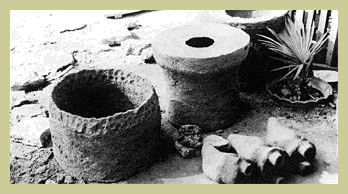
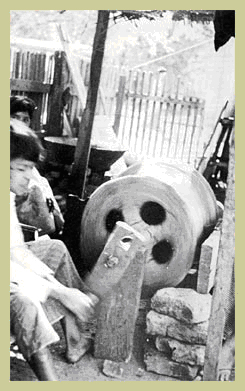
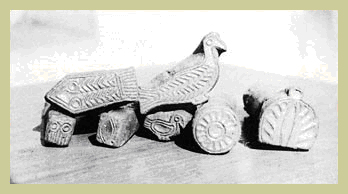
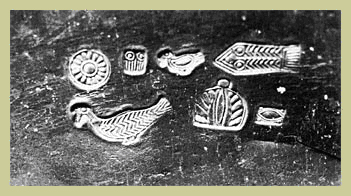
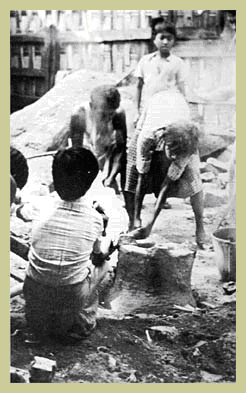
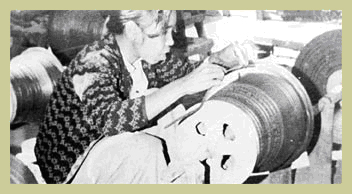





An expert in economics supplies you with a variety of resources to assist you in completing your assignment more quickly. Students struggle to implement appropriate scores due to a lack of awareness of assignment structure, citation systems, formatting rules, and other variables. Choose our best services if you are looking for the best completing my Economics Assignment Help .
ReplyDeleteAll The Right Movies Top 10 ranking of the greatest movie stories of all time. Featuring classics like The Empire Strikes Back, The Exorcist and Pulp.
ReplyDeletebest poker tips for beginners
investing in high-interest fixed deposit
best law schools in the World
boost your construction business sales
humble magnifying glass
February 2021 selfcareadvise
payroll software
best marketplaces online
holidaytakeoff about us
ReplyDeletetips & tricks + write for us
e-learning + write for us
hairstyle + write for us
mobile & app + write for us
create and sell online courses in 2022
Schools and Colleges valuablestudy
HIGH SCHOOL growacademics
all about rodtep scheme
difference between credit freeze vs credit lock
it magnate
ReplyDeletemake a career in genetics in india
multiply savings
pile up money
city news cast
discover what thin content
October 2021 primenewstime
topnotch story
create a viral social media strategy
ideas spending less
starting an export business
ReplyDeleteshowing true
choosing a personal loan
bankingcashier about us
it software tips
reliableapplication about us
Gaming techsourcecode
ONLINE EDUCATION educatedleader
generaleducator about us
effective tools, metrics, & strategies
Contact Us magazineheadlines
ReplyDeletethings to avoid when the second lockdown
coverpagestory about us
outfitstyling about us
homefamilyfun about us
preparing maintenance checklist
Flights & Car Rentals journeyupdates
plant protein differs
best diets for weight loss
how to write seo-friendly product
Contact Us cityoutdoorfun
ReplyDeletecomzip lining adventures
start my own clothing brand
March 2022 bankingschemes
diabetic diets help
best subtitle generators
June 2022 mostrecenttech
December 2021 itbusinesstrend
work from home
finding chance shopping
pregnancy conversations
ReplyDeleteContact Us managesalary
Contact Us expenseshelp
TRAVEL fastnewstime
need to adapt leadership skills
January 2022 topbusinessicon
Contact Us friendfamilyfun
Contact Us shoppingrightly
write good essay
lump sum amount
health things you should know in pregnancy
ReplyDeleteprime news room
personal finance is the action of applying
Business citybigstory
AI techgadgettime
Education newssofar
Finance nationnewstime
Business dailyoutfitidea
fantastic benefits of moisturizing
check online wholesale
top products for the best eye makeup
ReplyDeletebed bath & beyond coupons expire
TATOO ART slimfitnessguru
free slots no deposits games
techniques to enhance learning for your students
celebrity hairstyles and wedding
May 2022 edgylifestyle
may 2022 reputablecar
May 2022 cashcryptohelp
getcryptotips about us
June 2022 vviphousing
ReplyDeleteJune 2022 healthdietguru
red summer dress
pg rooms classifieds
The Documents of Vietnamese Ancient Culture III explores the history and culture of the State of Vietnam. The collection has fascinating information that relates to the country's history. A business major can learn from the online marketing dissertation writing service how to write an effective, academic paper.
ReplyDelete